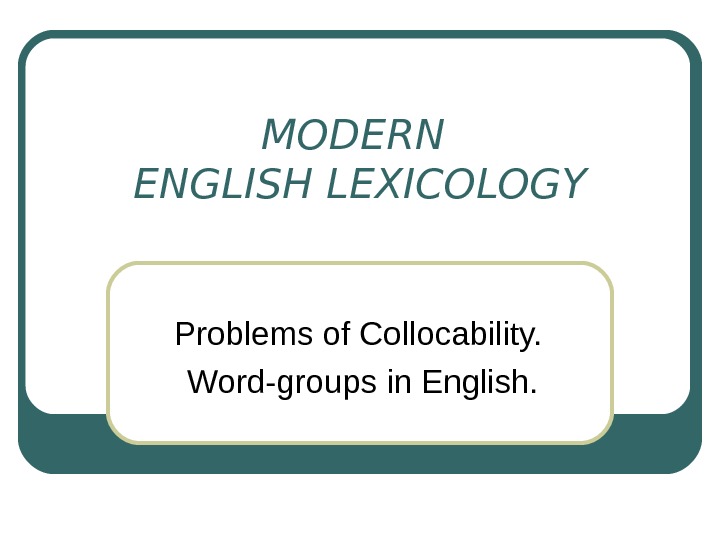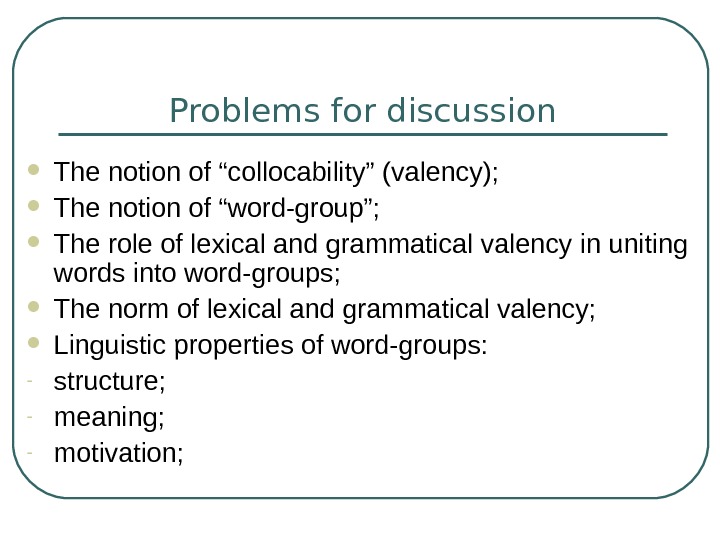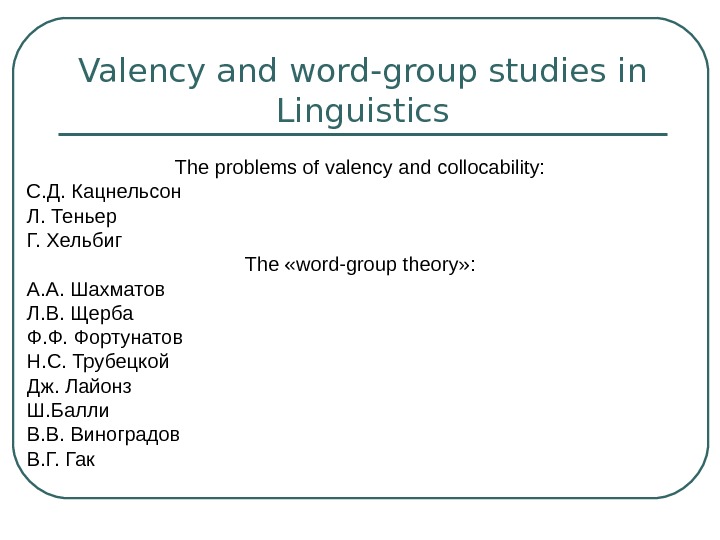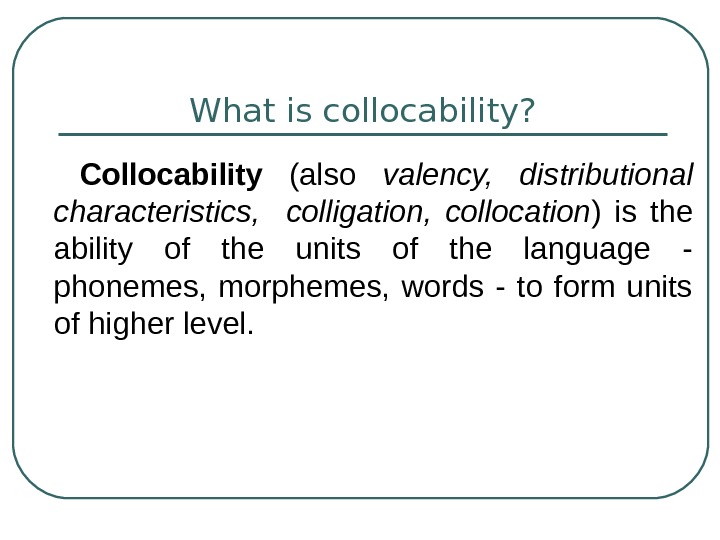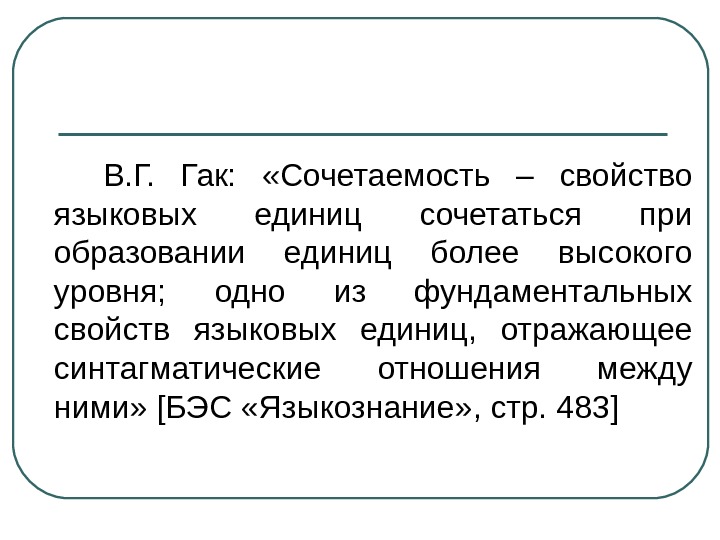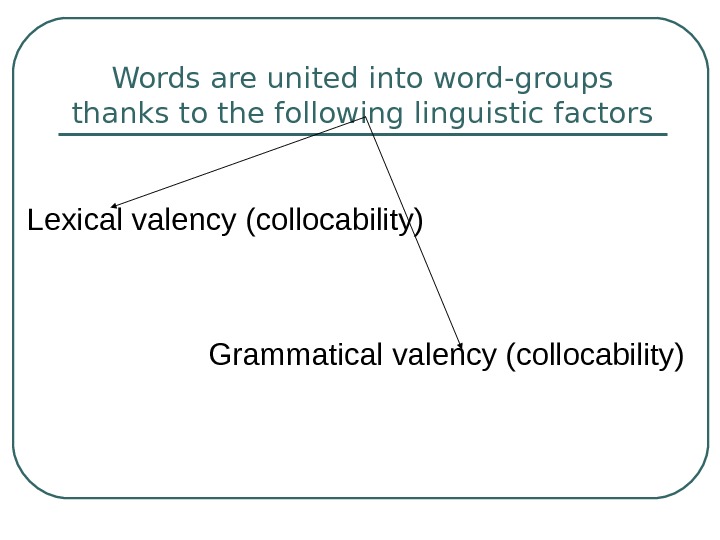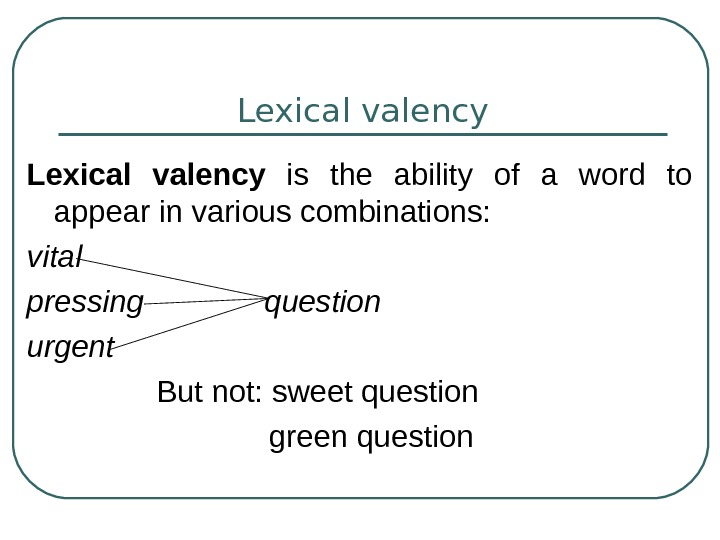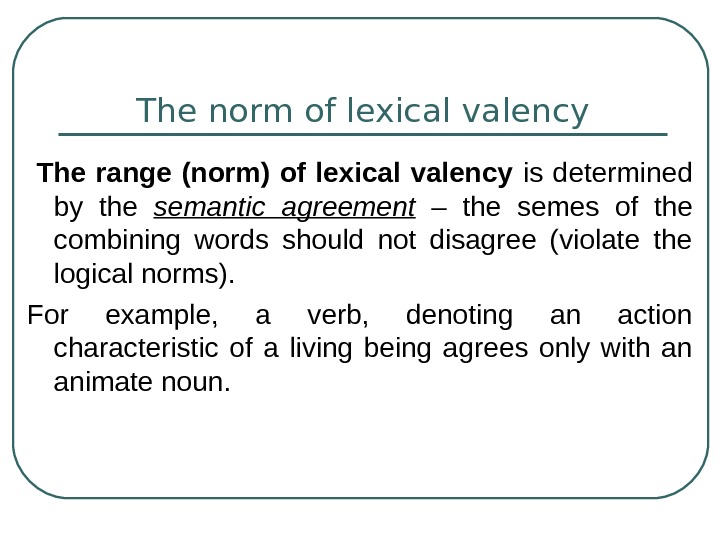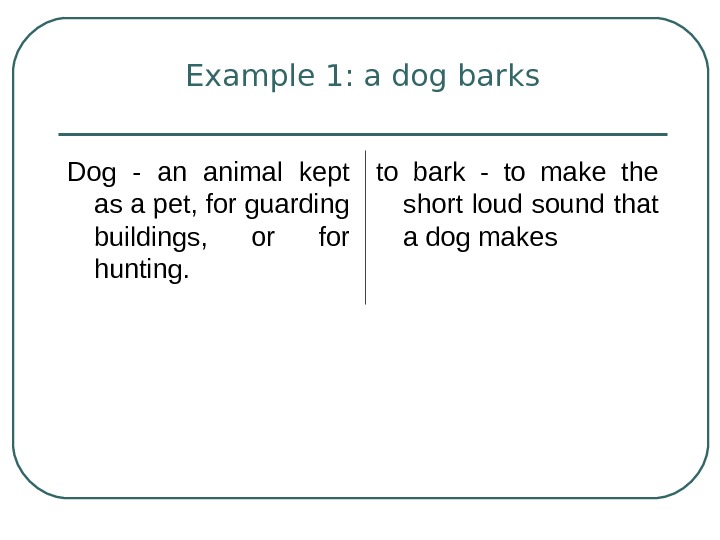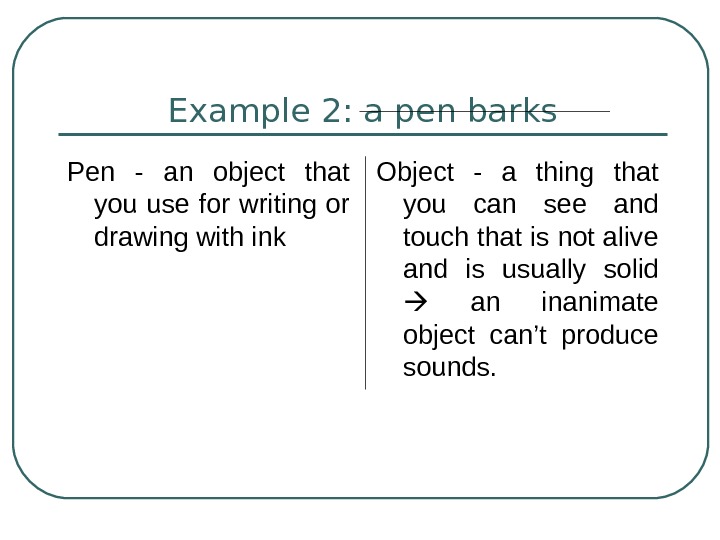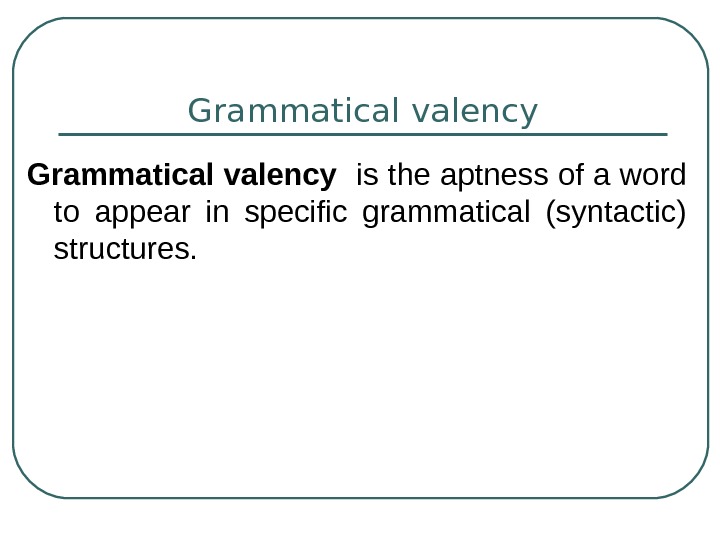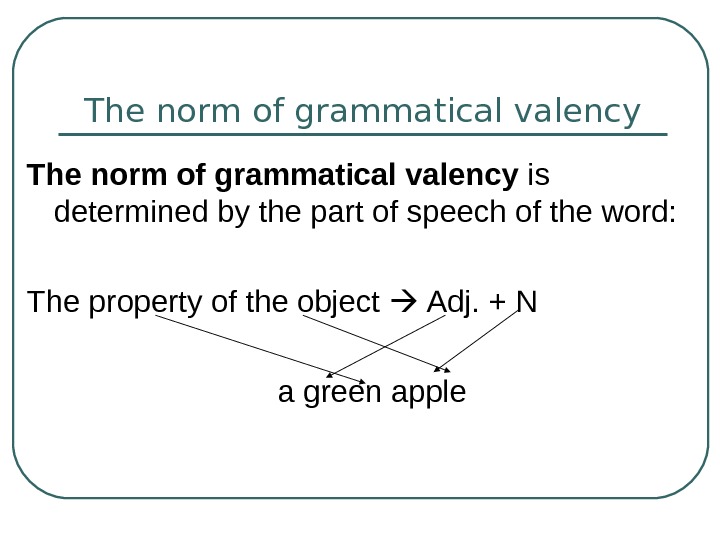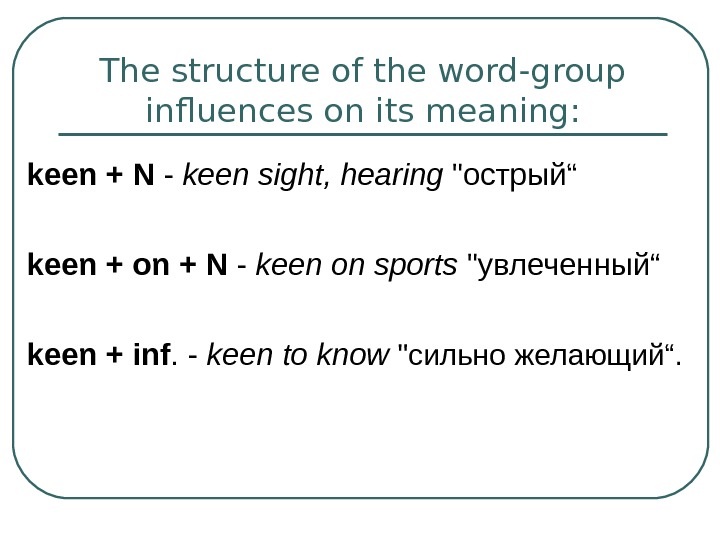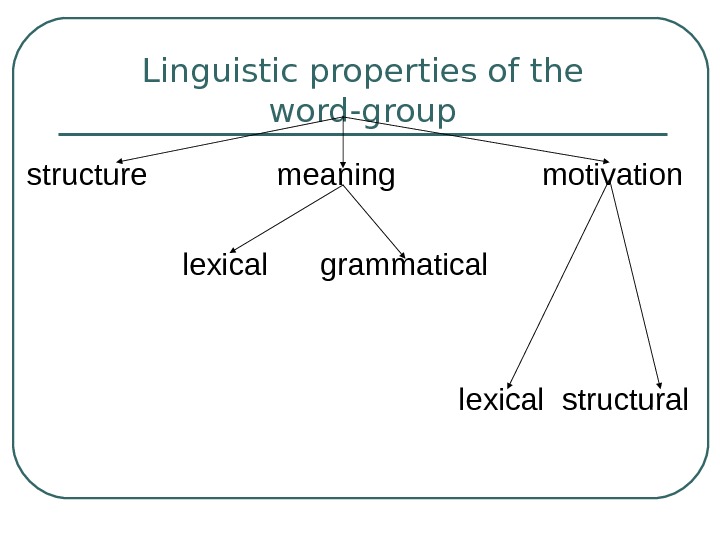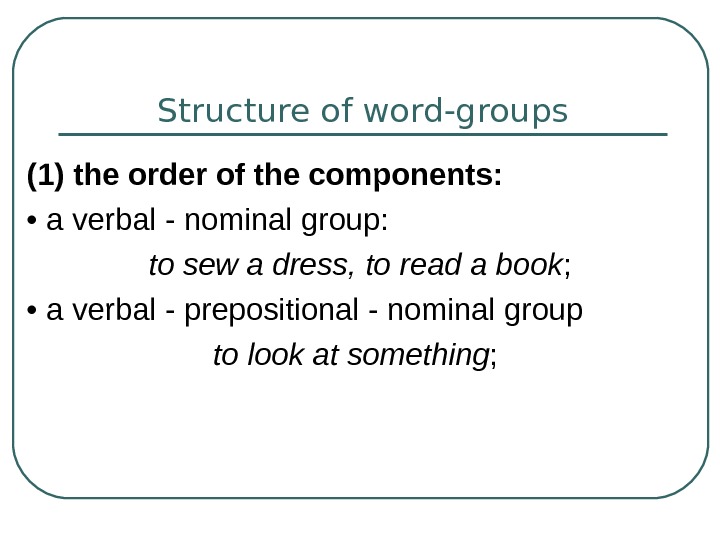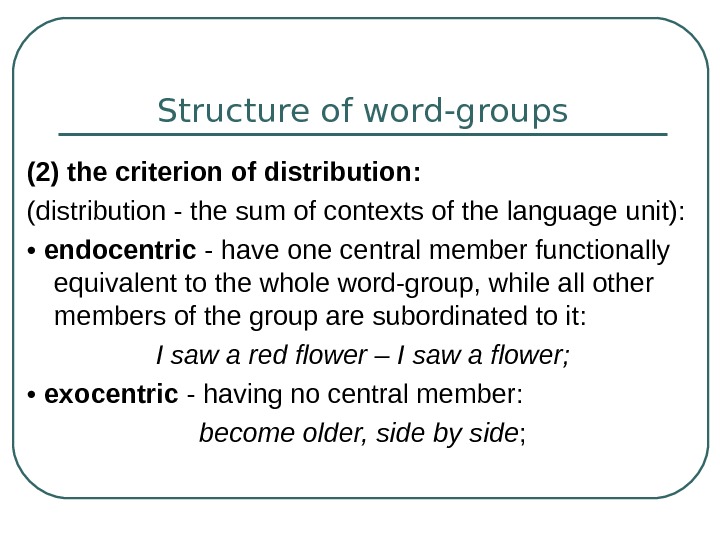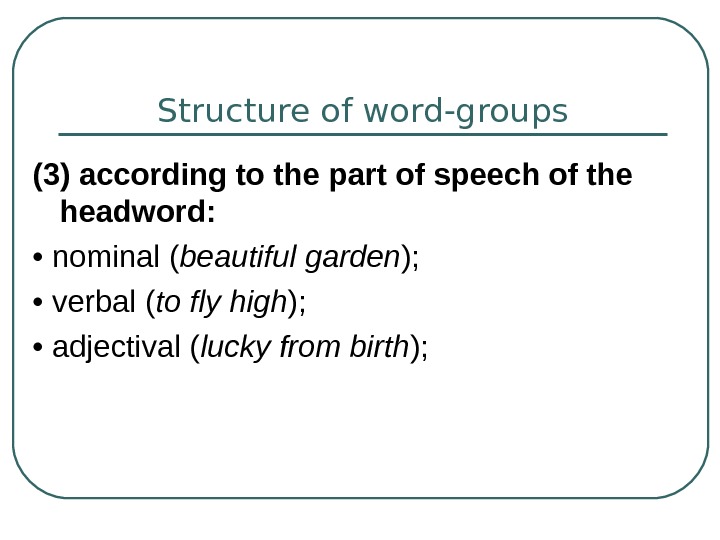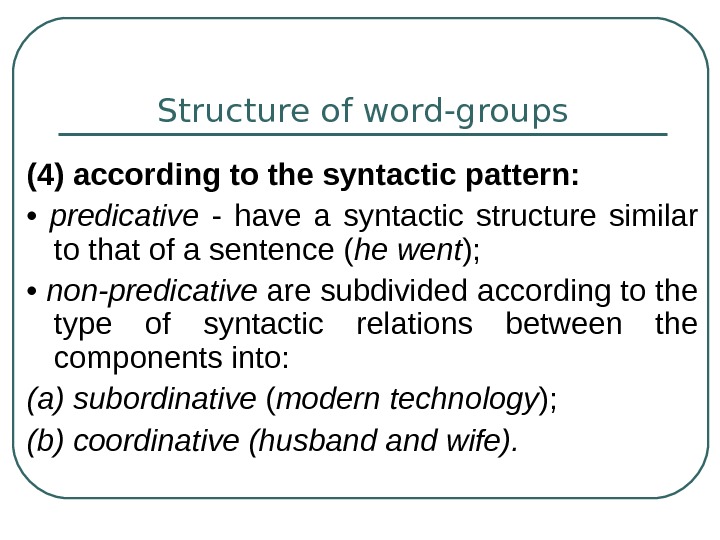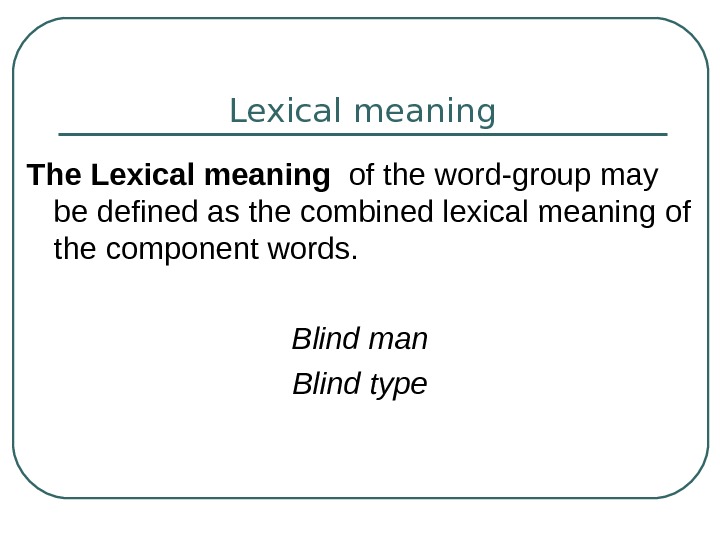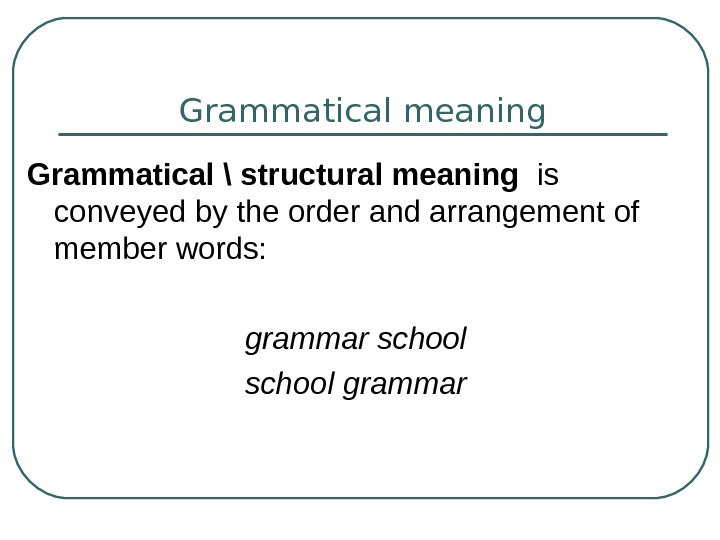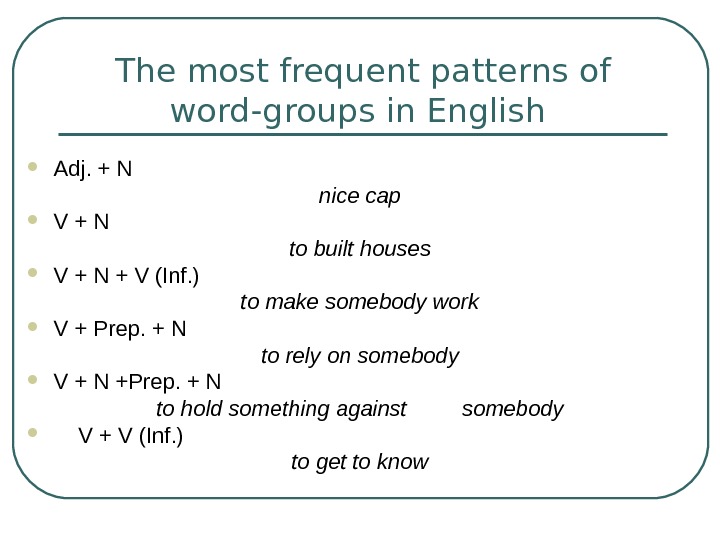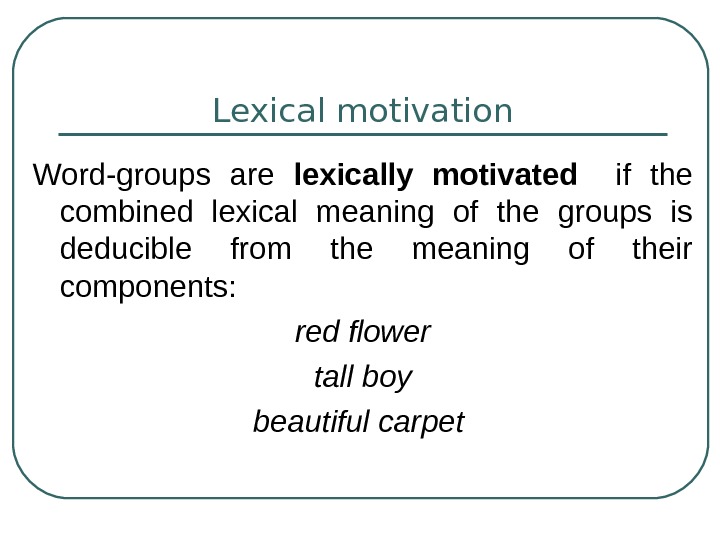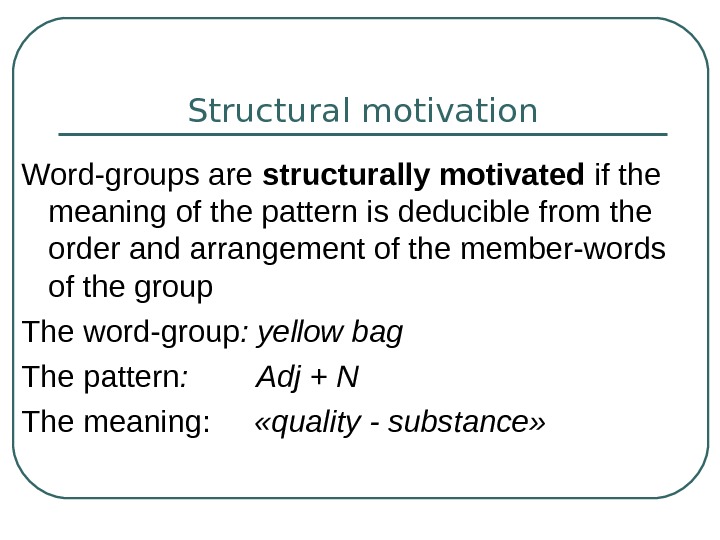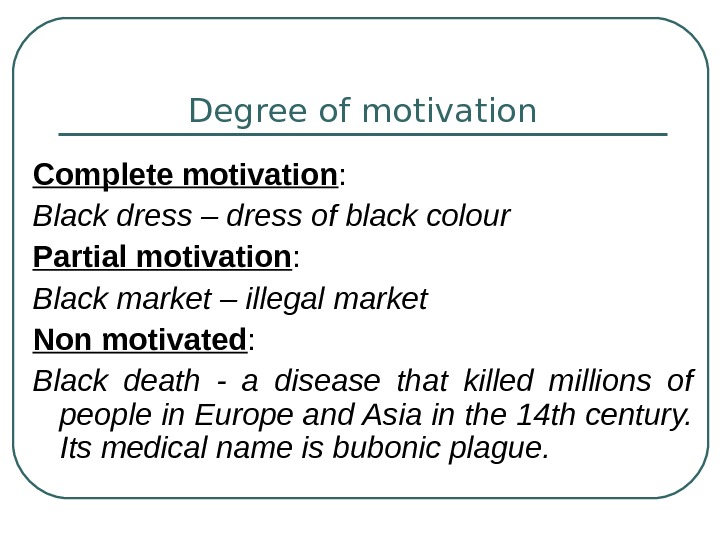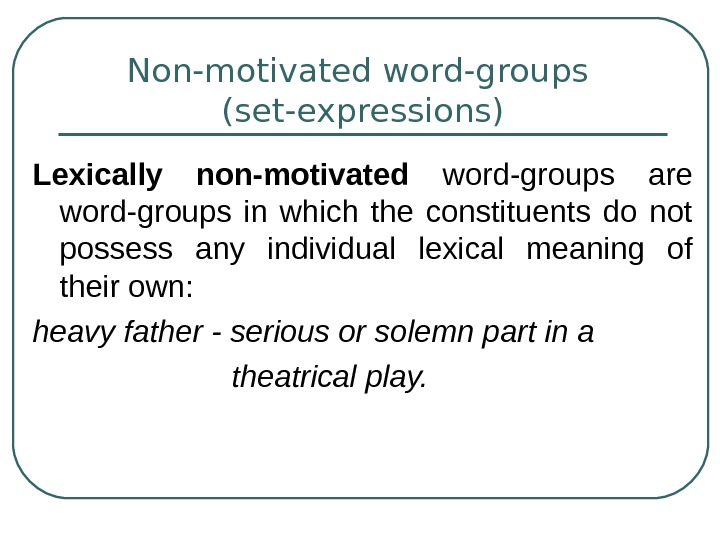As
with word-meaning, the meaning of word-groups may be analysed into
lexical
and grammatical
components.
§ 4. Lexical Meaning
The
lexical meaning of the word-group may be defined as the combined
lexical meaning of the component words. Thus the lexical meaning of
the word-group red
flower
may be described denotationally as the combined meaning of the words
red
and
flower.
It
should be pointed out, however, that the term combined
lexical
meaning
is not to imply that the meaning of the word-group is a mere additive
result of all the lexical meanings of the component members. As a
rule, the meanings of the component words are mutually dependent and
the meaning of the word-group naturally predominates over the lexical
meaning of its constituents.
Even
in word-groups made up of technical terms which are traditionally
held to be monosemantic the meaning of the word-group cannot be
described as the sum total of the meanings of its components. For
example, though the same adjective atomic
is
a component of a number of terminological word-groups, e.g. atomic
weight, atomic warfare, etc.,
the lexical meaning of the adjective is different and to a certain
degree subordinated to the meaning of the noun in each individual
word-group and consequently the meaning of the whole group is
modified.
Interdependence
of the lexical meanings of the constituent members of word-groups can
be readily observed in word-groups made up of polysemantic words. For
example, in the nominal group blind
man (cat, horse) only
one meaning of the adjective blind,
i.e.
‘unable to see’, is combined with the lexical meaning of the noun
man (cat, horse)
and
it is only one of the meanings of the noun man
— ‘human
being’ that is perceived in combination with the lexical meaning of
this adjective. The meaning of the same adjective in blind
type (print, handwriting) is
different.
As
can be seen from the above examples, polysemantic words are used in
word-groups only in one of their meanings. These meanings of the
component words in such word-groups are mutually interdependent and
inseparable. Semantic inseparability of word-groups that allows us to
treat them as self-contained lexical units is also clearly perceived
in the analysis of the connotational component of their lexical
meaning. Stylistic reference of word-groups, for example, may be
essentially different from that of the words making up these groups.
There is nothing colloquial or slangy about such words as old,
boy, bag, fun, etc.
when taken in isolation. The word-groups made up of these words, e.g.
old boy, bags of fun, are recognisably
colloquial.
Structural
Meaning
As
with polymorphemic words word-groups possess not only the lexical
meaning, but also the meaning conveyed mainly by the pattern of
arrangement of their constituents. A certain parallel can be drawn
between the meaning conveyed by the arrangement of morphemes in words
and the structural meaning of word-groups.1
It will be recalled that two compound words made up of lexically
identical stems may be different in meaning because of the difference
in the pattern of arrangement of the stems. For example, the meaning
of such words as dog-house
and
house-dog
is
different though the lexical meaning of the components is identical.
This is also true of word-groups. Such word-groups as school
grammar and
grammar
school are
semantically different because of the difference in the pattern of
arrangement of the component words. It is assumed that the structural
pattern of word-groups is the carrier of a certain semantic component
not necessarily dependent on the actual lexical meaning of its
members. In the example discussed above (school
grammar) the
structural meaning of the word-group may be abstracted from the group
and described as ‘quality-substance’ meaning. This is the meaning
expressed by the pattern of the word-group but not by either the word
school
or
the word grammar.
It follows
that we have to distinguish between the structural meaning of a given
type of word-group as such and the lexical meaning of its
constituents.
Соседние файлы в предмете [НЕСОРТИРОВАННОЕ]
- #
- #
- #
- #
- #
- #
- #
- #
- #
- #
- #
Ответы на госы по лексикологии
ЭКЗАМЕНАЦИОННЫЙ БИЛЕТ № 1
1. Lexicology, its aims and significance
Lexicology is a branch of linguistics which deals with a systematic description and study of the vocabulary of the language as regards its origin, development, meaning and current use. The term is composed of 2 words of Greek origin: lexis + logos. A word about words, or the science of a word. It also concerns with morphemes, which make up words and the study of a word implies reference to variable and fixed groups because words are components of such groups. Semantic properties of such words define general rules of their joining together. The general study of the vocabulary irrespective of the specific features of a particular language is known as general lexicology. Therefore, English lexicology is called special lexicology because English lexicology represents the study into the peculiarities of the present-day English vocabulary.
Lexicology is inseparable from: phonetics, grammar, and linguostylistics b-cause phonetics also investigates vocabulary units but from the point of view of their sounds. Grammar- grammatical peculiarities and grammatical relations between words. Linguostylistics studies the nature, functioning and structure of stylistic devices and the styles of a language.
Language is a means of communication. Thus, the social essence is inherent in the language itself. The branch of linguistics which deals with relations between the language functions on the one hand and the facts of social life on the other hand is termed sociolinguistics.
Modern English lexicology investigates the problems of word structure and word formation; it also investigates the word structure of English, the classification of vocabulary units, replenishment3 of the vocabulary; the relations between different lexical layers4 of the English vocabulary and some other. Lexicology came into being to meet the demands of different branches of applied linguistic! Namely, lexicography — a science and art of compiling dictionaries. It is also important for foreign language teaching and literary criticism.
2. Referential approach to meaning
SEMASIOLOGY
There are different approaches to meaning and types of meaning
Meaning is the object of semasiological study -> semasiology is a branch of lexicology which is concerned with the study of the semantic structure of vocabulary units. The study of meaning is the basis of all linguistic investigations.
Russian linguists have also pointed to the complexity of the phenomenon of meaning (Потебня, Щерба, Смирницкий, Уфимцева и др.)
There are 3 main types of definition of meaning:
(a) Analytical or referential definition
(b) Functional or contextual approach
(c) Operational or information-oriented definition of meaning
REFERENTIAL APPROACH
Within the referential approach linguists attempt at establishing interdependence between words and objects of phenomena they denote. The idea is illustrated by the so-called basic triangle:
Concept
Sound – form_ _ _ _ _ _ _ _ _ _ Referent
[kæt] (concrete object)
The diagram illustrates the correlation between the sound form of a word, the concrete object it denotes and the underlying concept. The dotted line suggests that there is no immediate relation between sound form and referent + we can say that its connection is conventional (human cognition).
However the diagram fails to show what meaning really is. The concept, the referent, or the relationship between the main and the concept.
The merits: it links the notion of meaning to the process of namegiving to objects, process of phenomena. The drawbacks: it cannot be applied to sentences and additional meanings that arise in the conversation. It fails to account for polysemy and synonymy and it operates with subjective and intangible mental process as neither reference nor concept belong to linguistic data.
ЭКЗАМЕНАЦИОННЫЙ БИЛЕТ № 2
1. Functional approach to meaning
SEMASIOLOGY
There are different approaches to meaning and types of meaning
Meaning is the object of semasiological study -> semasiology is a branch of lexicology which is concerned with the study of the semantic structure of vocabulary units. The study of meaning is the basis of all linguistic investigations.
Russian linguists have also pointed to the complexity of the phenomenon of meaning (Потебня, Щерба, Смирницкий, Уфимцева и др.)
There are 3 main types of definition of meaning:
(a) Analytical or referential definition
(b) Functional or contextual approach
(c) Operational or information-oriented definition of meaning
FUNCTIONAL (CONTEXTUAL) APPROACH
The supporters of this approach define meaning as the use of word in a language. They believe that meaning should be studied through contexts. If the distribution (position of a linguistic unit to other linguictic units) of two words is different we can conclude that heir meanings are different too (Ex. He looked at me in surprise; He’s been looking for him for a half an hour.)
However, it is hardly possible to collect all contexts for reliable conclusion. In practice a scholar is guided by his experience and intuition. On the whole, this approach may be called complimentary to the referential definition and is applied mainly in structural linguistics.
2. Classification of morphemes
A morpheme is the smallest indivisible two-facet language unit which implies an association of a certain meaning with a certain sound form. Unlike words, morphemes cannot function independently (they occur in speech only as parts of words).
Classification of Morphemes
Within the English word stock maybe distinguished morphologically segment-able and non-segment-able words (soundless, rewrite – segmentable; book, car — non-segmentable).
Morphemic segmentability may be of three types:
a) Complete segmentability is characteristic of words with transparent morphemic structure (morphemes can be easily isolated, e.g. heratless).
b) Conditional segmentability characterizes words segmentation of which into constituent morphemes is doubtful for semantic reasons (retain, detain, contain). Pseudo-morphemes
c) Defective morphemic segmentability is the property of words whose component morphemes seldom or never occur in other words. Such morphemes are called unique morphemes (cran – cranberry (клюква), let- hamlet (деревушка)).
· Semantically morphemes may be classified into: 1) root morphemes – radicals (remake, glassful, disorder — make, glass, order- are understood as the lexical centres of the words) and 2) non-root morphemes – include inflectional (carry only grammatical meaning and relevant only for the formation of word-forms) and affixational morphemes (relevant for building different types of stems).
· Structurally, morphemes fall into: free morphemes (coincides with the stem or a word-form. E.g. friend- of thenoun friendship is qualified as a free morpheme), bound morphemes (occurs only as a constituent part of a word. Affixes are bound for they always make part of a word. E.g. the suffixes –ness, -ship, -ize in the words darkness, friendship, to activize; the prefixes im-, dis-, de- in the words impolite, to disregard, to demobilize) and semi-free or semi-bound morphemes (can function both as affixes and free morphemes. E.g. well and half on the one hand coincide with the stem – to sleep well, half an hour, and on the other in the words – well-known, half-done).
ЭКЗАМЕНАЦИОННЫЙ БИЛЕТ № 3
1. Types of meaning
The word «meaning» is not homogeneous. Its components are described as «types of meaning». The two main types of meaning are grammatical and lexical meaning.
The grammatical meaning is the component of meaning, recurrent in identical sets of individual forms of words (e.g. reads, draws, writes – 3d person, singular; books, boys – plurality; boy’s, father’s – possessive case).
The lexical meaning is the meaning proper to the linguistic unit in all its forms and distribution (e.g. boy, boys, boy’s, boys’ – grammatical meaning and case are different but in all of them we find the semantic component «male child»).
Both grammatical meaning and lexical meaning make up the word meaning and neither of them can exist without the other.
There’s also the 3d type: lexico-grammatical (part of speech) meaning. Third type of meaning is called lexico-grammatical meaning (or part-of-speech meaning). It is a common denominator of all the meanings of words belonging to a lexical-grammatical class (nouns, verbs, adjectives etc. – all nouns have common meaning oа thingness, while all verbs express process or state).
Denotational meaning – component of the lexical meaning which makes communication possible. The second component of the lexical meaning is the connotational component – the emotive charge and the stylistic value of the word.
2. Syntactic structure and pattern of word-groups
The meaning of word groups can be defined as the combined lexical meaning of the component words but it is not a mere additive result of all the lexical meanings of components. The meaning of the word group itself dominates the meaning of the component members (Ex. an easy rule, an easy person).
The meaning of the word group is further complicated by the pattern of arrangement of its constituents (Ex. school grammar- grammar school).
That’s why we should bear in mind the existence of lexical and structural components of meaning in word groups, since these components are independent and inseparable. The syntactic structure (formula) implies the description of the order and arrangement of member-words as parts of speech («to write novels» — verb + noun; «clever at mathematics»- adjective + preposition + noun).
As a rule, the difference in the meaning of the head word is presupposed by the difference in the pattern of the word group in which the word is used (to get + noun = to get letters / presents; to get + to + noun = to get to town). If there are different patterns, there are different meanings. BUT: identity of patterns doesn’t imply identity of meanings.
Semanticallv. English word groups are analyzed into motivated word groups and non-motivated word groups. Word groups are lexically motivated if their meanings are deducible from the meanings of components. The degree of motivation may be different.
A blind man — completely motivated
A blind print — the degree of motivation is lower
A blind alley (= the deadlock) — the degree of motivation is still less.
Non-motivated word-groups are usually described as phraseological units.
ЭКЗАМЕНАЦИОННЫЙ БИЛЕТ № 4
1. Classification of phraseological units
The term «phraseological unit» was introduced by Soviet linguist (Виноградов) and it’s generally accepted in this country. It is aimed at avoiding ambiguity with other terms, which are generated by different approaches, are partially motivated and non-motivated.
The first classification of phraseological units was advanced for the Russian language by a famous Russian linguist Виноградов. According to the degree of idiomaticity phraseological units can be classified into three big groups: phraseological collocations (сочетания), phraseological unities (единства) and phraseological fusions (сращения).
Phraseological collocations are not motivated but contain one component used in its direct meaning, while the other is used metaphorically (e.g. to break the news, to attain success).
Phraseological unities are completely motivated as their meaning is transparent though it is transferred (e.g. to shoe one’s teeth, the last drop, to bend the knee).
Phraseological fusions are completely non-motivated and stable (e.g. a mare’s nest (путаница, неразбериха; nonsense), tit-for-tat – revenge, white elephant – expensive but useless).
But this classification doesn’t take into account the structural characteristic, besides it is rather subjective.
Prof. Смирнитский treats phraseological units as word’s equivalents and groups them into: (a) one-summit units => they have one meaningful component (to be tied, to make out); (b) multi-summit units => have two or more meaningful components (black art, to fish in troubled waters).
Within each of these groups he classifies phraseological units according to the part of speech of the summit constituent. He also distinguishes proper phraseological units or units with non-figurative meaning and idioms that have transferred meaning based on metaphor (e.g. to fall in love; to wash one’s dirty linen in public).
This classification was criticized as inconsistent, because it contradicts the principle of idiomaticity advanced by the linguist himself. The inclusion of phrasal verbs into phraseology wasn’t supported by any convincing argument.
Prof. Амазова worked out the so-called contextual approach. She believes that if 3 word groups make up a variable context. Phraseological units make up the so-called fixed context and they are subdivided into phrases and idioms.
2. Procedure of morphemic analysis
Morphemic analysis deals with segmentable words. Its procedure flows to split a word into its constituent morphemes, and helps to determine their number and type. It’s called the method of immediate and ultimate constituents. This method is based on the binary principle which allows to break morphemic structure of a word into 2 components at each stage. The analysis is completed when we arrive at constituents unable of any further division. E.g. Louis Bloomfield — classical example:
ungentlemanly
I. un-(IC/UC) +gentlemanly (IC) (uncertain, unhappy)
II. gentleman (IC) + -ly (IC/UC) (happily, certainly)
III. gentle (IC) +man (IC/UC) (sportsman, seaman)
IV. gent (IC/UC) + le (IC/UC) (gentile, genteel)
The aim of the analysis is to define the number and the type of morphemes.
As we break the word we obtain at any level only 2 immediate constituents, one of which is the stem of the given word. The morphemic analysis may be based either on the identification of affixational morphemes within a set of words, or root morphemes.
ЭКЗАМЕНАЦИОННЫЙ БИЛЕТ № 5
1. Causes, nature and results of semantic change
The set of meanings the word possesses isn’t fixed. If approached diachronically, the polysemy reflects sources and types of semantic changes. The causes of such changes may be either extra-linguistic including historical and social factors, foreign influence and the need for a new name, or linguistic, which are due to the associations that words acquire in speech (e.g. «atom» has a Greek origin, now is used in physics; «to engage» in the meaning «to invite» appeared in English due to French influence = > to engage for a dance). To unleash war – развязать войну – but originally – to unleash dogs)
The nature of semantic changes may be of two main types: 1) Similarity of meaning (metaphor). It implies a hidden comparison (bitter style – likeness of meaning or metonymy). It is the process of associating two references, one of which is part of the other, or is closely connected with it. In other words, it is nearest in type, space or function (e.g. «table» in the meaning of “food” or “furniture” [metonymy]).
The semantic change may bring about following results: 1. narrowing of meaning (e.g. “success” – was used to denote any kind of result, but today it is onle “good results”);
2. widening of meaning (e.g. “ready” in Old English was derived from “ridan” which went to “ride” – ready for a ride; but today there are lots of meanings),
3. degeneration of meaning — acquisition by a word of some derogatory or negative emotive charge (e.g. «villain» was borrowed from French “farm servant”; but today it means “a wicked person”).
4. amelioration of meaning — acquisition by a word of some positive emotive charge (e.g. «kwen» in Old English meant «a woman» but in Modern English it is «queen»).
It is obvious that 3, 4 result illustrate the change in both denotational and connotational meaning. 1, 2 change in the denotational.
The change of meaning can also be expressed through a change in the number and arrangement of word meanings without any other changes in the semantic structure of a word.
2. Productivity of word-formation means
According to Смирницкий, word-formation is the system of derivative types of words and the process of creating new words from the material available in the language. Words are formed after certain structural and semantic patterns. The main two types of word-formation are: word-derivation and word-composition (compounding).
The degree of productivity of word-formation and factors that favor it make an important aspect of synchronic description of every derivational pattern within the two types of word-formation. The two general restrictions imposed on the derivational patterns are: 1. the part of speech in which the pattern functions; 2. the meaning which is attached to it.
Three degrees of productivity are distinguished for derivational patterns and individual derivational affixes: highly productive, productive or semi-productive and non-productive.
Productivity of derivational patterns and affixes shouldn’t be identified with frequency of occurrence in speech (e.g.-er — worker, -ful – beautiful are active suffixes because they are very frequently used. But if -er is productive, it is actively used to form new words, while -ful is non-productive since no new words are built).
ЭКЗАМЕНАЦИОННЫЙ БИЛЕТ № 6
1. Morphological, phonetical and semantic motivation
A new meaning of a word is always motivated. Motivation — is the connection between the form of the word (i.e. its phonetic, morphological composition and structural pattern) and its meaning. Therefore a word may be motivated phonetically, morphologically and semantically.
Phonetically motivated words are not numerous. They imitate the sounds (e.g. crash, buzz, ring). Or sometimes they imitate quick movement (e.g. rain, swing).
Morphological motivation is expressed through the relationship of morphemes => all one-morpheme words aren’t motivated. The words like «matter» are called non-motivated or idiomatic while the words like «cranberry» are partially motivated because structurally they are transparent, but «cran» is devoid of lexical meaning; «berry» has its lexical meaning.
Semantic motivation is the relationship between the direct meaning of the word and other co-existing meanings or lexico-semantic variants within the semantic structure of a polysemantic word (e.g. «root»— «roots of evil» — motivated by its direct meaning, «the fruits of peace» — is the result).
Motivation is a historical category and it may fade or completely disappear in the course of years.
2. Classification of compounds
The meaning of a compound word is made up of two components: structural meaning of a compound and lexical meaning of its constituents.
Compound words can be classified according to different principles.
1. According to the relations between the ICs compound words fall into two classes: 1) coordinative compounds and 2) subordinative compounds.
In coordinative compounds the two ICs are semantically equally important. The coordinative compounds fall into three groups:
a) reduplicative compounds which are made up by the repetition of the same base, e.g. pooh-pooh (пренебрегать), fifty-fifty;
b) compounds formed by joining the phonically variated rhythmic twin forms, e.g. chit-chat, zig-zag (with the same initial consonants but different vowels); walkie-talkie (рация), clap-trap (чепуха) (with different initial consonants but the same vowels);
c) additive compounds which are built on stems of the independently functioning words of the same part of speech, e.g. actor-manager, queen-bee.
In subordinative compounds the components are neither structurally nor semantically equal in importance but are based on the domination of the head-member which is, as a rule, the second IС, e.g. stone-deaf, age-long. The second IС preconditions the part-of-speech meaning of the whole compound.
2. According to the part of speech compounds represent they fall into:
1) compound nouns, e.g. sunbeam, maidservant;
2) compound adjectives, e.g. heart-free, far-reaching;
3) compound pronouns, e.g. somebody, nothing;
4) compound adverbs, e.g. nowhere, inside;
5) compound verbs, e.g. to offset, to bypass, to mass-produce.
From the diachronic point of view many compound verbs of the present-day language are treated not as compound verbs proper but as polymorphic verbs of secondary derivation. They are termed pseudo-compounds and are represented by two groups: a) verbs formed by means of conversion from the stems of compound nouns, e.g. to spotlight (from spotlight); b) verbs formed by back-derivation from the stems of compound nouns, e.g. to babysit (from baby-sitter).
However synchronically compound verbs correspond to the definition of a compound as a word consisting of two free stems and functioning in the sentence as a separate lexical unit. Thus, it seems logical to consider such words as compounds by right of their structure.
3. According to the means of composition compound words are classified into:
1) compounds composed without connecting elements, e.g. heartache, dog-house;
2)compounds composed with the help of a vowel or a consonant as a linking element, e.g. handicraft, speedometer, statesman;
3) compounds composed with the help of linking elements represented by preposition or conjunction stems, e.g. son-in-law, pepper-and-salt.
4. According to the type of bases that form compounds the following classes can be singled out:
1) compounds proper that are formed by joining together bases built on the stems or on the word-forms with or without a linking element, e.g. door-step, street-fighting;
2) derivational compounds that are formed by joining affixes to the bases built on the word-groups or by converting the bases built on the word-groups into other parts of speech, e.g. long-legged —> (long legs) + -ed; a turnkey —> (to turn key) + conversion. Thus, derivational compounds fall into two groups: a) derivational compounds mainly formed with the help of the suffixes -ed and -er applied to bases built, as a rule, on attributive phrases, e.g. narrow-minded, doll-faced, lefthander; b) derivational compounds formed by conversion applied to bases built, as a rule, on three types of phrases — verbal-adverbial phrases (a breakdown), verbal-nominal phrases (a kill-joy) and attributive phrases (a sweet-tooth).
ЭКЗАМЕНАЦИОННЫЙ БИЛЕТ № 7
1. Diachronic and synchronic approaches to polysemy
Diachronically, polysemy is understood as the growth and development of the semantic structure of the word. Historically we differentiate between the primary and secondary meanings of words.
The relation between these meanings isn’t only the one of order of appearance but it is also the relation of dependence = > we can say that secondary meaning is always the derived meaning (e.g. dog – 1. animal, 2. despicable person)
Synchronically it is possible to distinguish between major meaning of the word and its minor meanings. However it is often hard to grade individual meaning of the word in order of their comparative value (e.g. to get the letter — получить письмо; to get to London — прибыть в Лондон — minor).
The only more or less objective criterion in this case is the frequency of occurrence in speech (e.g. table – 1. furniture, 2. food). The semantic structure is never static and the primary meaning of a word may become synchronically one of the minor meanings and vice versa. Stylistic factors should always be taken into consideration
Polysemy of words: «yellow»- sensational (Am., sl.)
The meaning which has the highest frequency is the one representative of the whole semantic structure of the word. The Russian equivalent of «a table» which first comes to your mind and when you hear this word is ‘cтол» in the meaning «a piece of furniture». And words that correspond in their major meanings in two different languages are referred to as correlated words though their semantic structures may be different.
Primary meaning — historically first.
Major meaning — the most frequently used meaning of the word synchronically.
2. Typical semantic relations between words in conversion pairs
We can single out the following typical semantic relation in conversion pairs:
1) Verbs converted from nouns (denominal verbs):
a) Actions characteristic of the subject (e.g. ape – to ape – imitate in a foolish way);
b) Instrumental use of the object (e.g. whip — to whip – strike with a whip);
c) Acquisition or addition of the objects (e.g. fish — to fish — to catch fish);
d) Deprivation of the object (e.g. dust — to dust – remove dust).
2) Nouns converted from verbs (deverbal nouns):
a) Instance of the action (e.g. to move — a move = change of position);
b) Agent of an action (e.g. to cheat — a cheat – a person who cheats);
c) Place of the action (e.g. to walk-a walk – a place for walking);
d) Object or result of the action (e.g. to find- a find – something found).
ЭКЗАМЕНАЦИОННЫЙ БИЛЕТ № 8
1. Classification of homonyms
Homonyms are words that are identical in their sound-form or spelling but different in meaning and distribution.
1) Homonyms proper are words similar in their sound-form and graphic but different in meaning (e.g. «a ball»- a round object for playing; «a ball»- a meeting for dances).
2) Homophones are words similar in their sound-form but different in spelling and meaning (e.g. «peace» — «piece», «sight»- «site»).
3) Homographs are words which have similar spelling but different sound-form and meaning (e.g. «a row» [rau]- «a quarrel»; «a row» [rəu] — «a number of persons or things in a more or less straight line»)
There is another classification by Смирницкий. According to the type of meaning in which homonyms differ, homonyms proper can be classified into:
I. Lexical homonyms — different in lexical meaning (e.g. «ball»);
II. Lexical-grammatical homonyms which differ in lexical-grammatical meanings (e.g. «a seal» — тюлень, «to seal» — запечатывать).
III. Grammatical homonyms which differ in grammatical meaning only (e.g. «used» — Past Indefinite, «used»- Past Participle; «pupils»- the meaning of plurality, «pupil’s»- the meaning of possessive case).
All cases of homonymy may be subdivided into full and partial homonymy. If words are identical in all their forms, they are full homonyms (e.g. «ball»-«ball»). But: «a seal» — «to seal» have only two homonymous forms, hence, they are partial homonyms.
2. Classification of prefixes
Prefixation is the formation of words with the help of prefixes. There are about 51 prefixes in the system of modern English word-formation.
1. According to the type they are distinguished into: a) prefixes that are correlated with independent words (un-, dis-), and b) prefixes that are correlated with functional words (e.g. out, over. under).
There are about 25 convertive prefixes which can transfer words to a different part of speech (E.g. embronze59).
Prefixes may be classified on different principles. Diachronically they may be divided into native and foreign origin, synchronically:
1. According to the class they preferably form: verbs (im, un), adjectives (un-, in-, il-, ir-) and nouns (non-, sub-, ex-).
2. According to the lexical-grammatical type of the base they are added to:
a). Deverbal — rewrite, overdo;
b). Denominal — unbutton, detrain, ex-president,
c). Deadjectival — uneasy, biannual.
It is of interest to note that the most productive prefixal pattern for adjectives is the one made up of the prefix un- and the base built either on adjectival stems or present and past participle, e.g. unknown, unsmiling, unseen etc.
3. According to their semantic structure prefixes may fall into monosemantic and polysemantic.
4. According to the generic-denotational meaning they are divided into different groups:
a). Negative prefixes: un-, dis-, non-, in-, a- (e.g. unemployment, non-scientific, incorrect, disloyal, amoral, asymmetry).
b). Reversative or privative60 prefixes: un-, de-, dis- (e.g. untie, unleash, decentralize, disconnect).
c). Pejorative prefixes: mis-, mal-, pseudo- (e.g. miscalculate, misinform, maltreat, pseudo-classicism).
d). Prefixes of time and order: fore-, pre-, post-, ex- (e.g. foretell, pre-war, post-war, ex-president).
e). Prefix of repetition re- (e.g. rebuild, rewrite).
f). Locative prefixes: super-, sub-, inter-, trans- (e.g. superstructure, subway, inter-continental, transatlantic).
5. According to their stylistic reference:
a). Neutral: un-, out-, over-, re-, under- (e.g. outnumber, unknown, unnatural, oversee, underestimate).
b). Stylistically marked: pseudo-, super-, ultra-, uni-, bi- (e.g. pseudo-classical, superstructure, ultra-violet, unilateral) they are bookish.
6. According to the degree of productivity: a). highly productive, b). productive, c). non-productive.
ЭКЗАМЕНАЦИОННЫЙ БИЛЕТ № 9
.
1. Types of linguistic contexts
The term “context” denotes the minimal stretch of speech determining each individual meaning of the word. Contexts may be of two types: linguistic (verbal) and extra-linguistic (non-verbal).
Linguistic contexts may be subdivided into lexical and grammatical.
In lexical contexts of primary importance are the groups of lexical items combined with polysemantic word under consideration (e.g. adj. “heavy” is used with the words “load, table” means ‘of great weight’ ; but with natural phenomena “rain, storm, snow, wind’ it is understood as ‘abundant, striking, falling with force’; and if with “industry, artillery, arms” – ‘the larger kind of smth’). The meaning at the level of lexical contexts is sometimes described as meaning by collocation.
In grammatical meaning it is the grammatical (syntactic) structure of the context that serves to determine various individual meanings of a polysemantic word (e.g. the meaning of the verb “to make” – ‘to force, to induce’ is found only in the syntactic structure “to make + prn. +verb”; another meaning ‘to become’ – “to make + adj. + noun” (to make a good teacher, wife)). Such meanings are sometimes described as grammatically bound meanings.
2. Classification of suffixes
Suffixation is the formation of words with the help of suffixes. Suffixes usually modify the lexical meaning of the base and transfer words to a different part of speech. There are suffixes, however, which do not shift words from one part of speech into another; a suffix of this kind usually transfers a word into a different semantic group, e.g. a concrete noun becomes an abstract one, as in the case with child — childhood, friend- friendship etc. Suffixes may be classified:
1. According to the part of speech they form
a). Noun-suffixes: -er, -dom, -ness, -ation (e.g. teacher, freedom, brightness, justification).
b). Adjective-suffixes: -able, -less, -ful, -ic, -ous (e.g. agreeable, careless, doubtful, poetic, courageous).
c). Verb-suffixes: -en, -fy, -ize (e.g. darken, satisfy, harmonize).
d). Adverb-suffixes: -ly, -ward (e.g. quickly, eastward).
2. According to the lexico-grammatical character of the base the suffixes are usually added to:
a). Deverbal suffixes (those added to the verbal base):-er, -ing, -ment, -able (speaker, reading, agreement, suitable).
b). Denominal suffixes (those added to the noun base):-less, -ish, -ful, -ist, -some (handless, childish, mouthful, troublesome).
c). Deadjectival suffixes (those affixed to the adjective base):-en, -ly, -ish, -ness (blacken, slowly, reddish, brightness).
3. According to the meaning expressed by suffixes:
a). The agent of an action: -er, -ant (e.g. baker, dancer, defendant), b). Appurtenance64: -an, -ian, -ese (e.g. Arabian, Elizabethan, Russian, Chinese, Japanese).
c). Collectivity: -age, -dom, -ery (-ry) (e.g. freightage, officialdom, peasantry).
d). Diminutiveness: -ie, -let, -ling (birdie, girlie, cloudlet, booklet, darling).
4. According to the degree of productivity:
a). Highly productive
b). Productive
c). Non-productive
5. According to the stylistic value:
a). Stylistically neutral:-able, -er, -ing.
b). Stylistically marked:-oid, -i/form, -aceous, -tron (e.g. asteroid)
ЭКЗАМЕНАЦИОННЫЙ БИЛЕТ № 10
1. Semantic equivalence and synonymy
The traditional initial category of words that can be singled out on the basis of proximity is synonyms. The degree of proximity varies from semantic equivalence to partial semantic similarity. The classes of full synonyms are very rare and limited mainly two terms.
The greatest degree of similarity is found in those words that are identical in their denotational aspect of meaning and differ in connotational one (e.g. father- dad; imitate – monkey). Such synonyms are called stylistic synonyms. However, in the major of cases the change in the connotational aspect of meaning affects in some way the denotational aspect. These synonyms of the kind are called ideographic synonyms (e.g. clever – bright, smell – odor). Differ in their denotational aspect ideographic synonyms (kill-murder, power – strength, etc.) – these synonyms are most common.
It is obvious that synonyms cannot be completely interchangeable in all contexts. Synonyms are words different in their sound-form but similar in their denotational aspect of meaning and interchangeable at least in some contexts.
Each synonymic group comprises a dominant element. This synonymic dominant is general term which has no additional connotation (e.g. famous, celebrated, distinguished; leave, depart, quit, retire, clear out).
Syntactic dominants have high frequency of usage, vast combinability and lack connotation.
2. Derivational types of words
The basic units of the derivative structure of words are: derivational basis, derivational affixes, and derivational patterns.
The relations between words with a common root but of different derivative structure are known as derivative relations.
The derivational base is the part of the word which establishes connections with the lexical unit that motivates the derivative and defines its lexical meaning. It’s to this part of the word (derivational base) that the rule of word formation is applied. Structurally, derivational bases fall into 3 classes: 1. Bases that coincide with morphological stems (beautiful, beautifully); 2. Bases that coincide with word-forms (unknown- limited mainly to verbs); 3. Bases that coincide with word groups. They are mainly active in the class of adjectives and nouns (blue-eyed, easy-going).
According to their derivational structure words fall into: simplexes (simple, non-derived words) and complexes (derivatives). Complexes are grouped into: derivatives and compounds. Derivatives fall into: affixational (suffixal and affixal) types and conversions. Complexes constitute the largest class of words. Both morphemic and derivational structure of words is subject to various changes in the course of time.
ЭКЗАМЕНАЦИОННЫЙ БИЛЕТ № 11
1. Semantic contrasts and antonymy
The semantic relations of opposition are the basis for grouping antonyms. The term «antonym» is of Greek origin and means “opposite name”. It is used to describe words different in some form and characterised by different types of semantic contrast of denotational meaning and interchangeability at least in some contexts.
Structurally, all antonyms can be subdivided into absolute (having different roots) and derivational (of the same root), (e.g. «right»- «wrong»; «to arrive»- «to leave» are absolute antonyms; but «to fit» — «to unfit» are derivational).
Semantically, all antonyms can be divided in at least 3 groups:
a) Contradictories. They express contradictory notions which are mutually opposed and deny each other. Their relations can be described by the formula «A versus NOT A»: alive vs. dead (not alive); patient vs. impatient (not patient). Contradictories may be polar or relative (to hate- to love [not to love doesn’t mean «hate»]).
b) Contraries are also mutually opposed, but they admit some possibility between themselves because they are gradable (e.g. cold – hot, warm; hot – cold, cool). This group also includes words opposed by the presence of such components of meaning as SEX and AGE (man -woman; man — boy etc.).
c) Incompatibles. The relations between them are not of contradiction but of exclusion. They exclude possibilities of other words from the same semantic set (e.g. «red»- doesn’t mean that it is opposed to white it means all other colors; the same is true to such words as «morning», «day», «night» etc.).
There is another type of opposition which is formed with reversive antonyms. They imply the denotation of the same referent, but viewed from different points (e.g. to buy – to sell, to give – to receive, to cause – to suffer)
A polysemantic word may have as many antonyms as it has meanings. But not all words and meanings have antonyms!!! (e.g. «a table»- it’s difficult to find an antonym, «a book»).
Relations of antonymy are limited to a certain context + they serve to differentiate meanings of a polysemantic word (e.g. slice of bread — «thick» vs. «thin» BUT: person — «fat» vs. «thin»).
2. Types of word segmentability
Within the English word stock maybe distinguished morphologically segment-able and non-segmentable words (soundless, rewrite — segmentable; book, car — non-segmentable).
Morphemic segmentability may be of three types: 1. complete, 2. conditional, 3. defective.
A). Complete segmentability is characteristic of words with transparent morphemic structure. Their morphemes can be easily isolated which are called morphemes proper or full morphemes (e.g. senseless, endless, useless). The transparent morphemic structure is conditioned by the fact that their constituent morphemes recur with the same meaning in a number of other words.
B). Conditional segmentability characterizes words segmentation of which into constituent morphemes is doubtful for semantic reasons (e.g. retain, detain, contain). The sound clusters «re-, de-, con-» seem to be easily isolated since they recur in other words but they have nothing in common with the morphemes «re, de-, con-» which are found in the words «rewrite», «decode», «condensation». The sound-clusters «re-, de-, con-» can possess neither lexical meaning nor part of speech meaning, but they have differential and distributional meaning. The morphemes of the kind are called pseudo-morphemes (quasi morphemes).
C). Defective morphemic segmentability is the property of words whose component morphemes seldom or never recur in other words. Such morphemes are called unique morphemes. A unique morpheme can be isolated and displays a more or less clear meaning which is upheld by the denotational meaning of the other morpheme of the word (cranberry, strawberry, hamlet).
ЭКЗАМЕНАЦИОННЫЙ БИЛЕТ № 12
1. The main features of A.V.Koonin’s approach to phraseology
Phraseology is regarded as a self-contained branch of linguistics and not as a part of lexicology.
His classification is based on the combined structural-semantic principle and also considers the level of stability of phraseological units.
Кунин subdivides set-expressions into: phraseological units or idioms(e.g. red tape, mare’s nest, etc.), semi-idioms and phraseomatic units(e.g. win a victory, launch a campaign, etc.).
Phraseological units are structurally separable language units with completely or partially transferred meanings (e.g. to kill two birds with one stone, to be in a brown stubby – to be in low spirits). Semi-idioms have both literal and transferred meanings. The first meaning is usually terminological or professional and the second one is transferred (e.g. to lay down one’s arms). Phraseomatic units have literal or phraseomatically bound meanings (e.g. to pay attention to smth; safe and sound).
Кунин assumes that all types of set expressions are characterized by the following aspects of stability: stability of usage (not created in speech and are reproduced ready-made); lexical stability (components are irreplaceable (e.g. red tape, mare’s nest) or partly irreplaceable within the limits of lexical meaning, (e.g. to dance to smb tune/pipe; a skeleton in the cupboard/closet; to be in deep water/waters)); semantic complexity (despite all occasional changes the meaning is preserved); syntactic fixity.
Idioms and semi-idioms are much more complex in structure than phraseological units. They have a broad stylistic range and they admit of more complex occasional changes.
An integral part of this approach is a method of phraseological identification which helps to single out set expressions in Modern English.
2. Types and ways of forming words
According to Смирницкий word-formation is a system of derivative types of words and the process of creating new words from the material available in the language after certain structural and semantic patterns. The main two types are: word-derivation and word-composition (compounding).
The basic ways of forming words in word-derivation are affixation and conversion (the formation of a new word by bringing a stem of this word into a different formal paradigm, e.g. a fall from to fall).
There exist other types: semantic word-building (homonymy, polysemy), sound and stress interchange (e.g. blood – bleed; increase), acronymy (e.g. NATO), blending (e.g. smog = smoke + fog) and shortening of words (e.g. lab, maths). But they are different in principle from derivation and compound because they show the result but not the process.
ЭКЗАМЕНАЦИОННЫЙ БИЛЕТ № 13
1. Origin of derivational affixes
From the point of view of their origin, derivational affixes are subdivided into native (e.g suf.- nas, ish, dom; pref.- be, mis, un) and foreign (e.g. suf.- ation, ment, able; pref.- dis, ex, re).
Many original affixes historically were independent words, such as dom, hood and ship. Borrowed words brought with them their derivatives, formed after word-building patterns of their languages. And in this way many suffixes and prefixes of foreign origin have become the integral part of existing word-formation (e.g. suf.- age; pref.- dis, re, non). The adoption of foreign words resulted into appearance of hybrid words in English vocabulary. Sometimes a foring stem is combined with a native suffix (e.g. colourless) and vise versa (e.g. joyous).
Reinterpretation of verbs gave rise to suffix-formation source language (e.g. “scape” – seascape, moonscape – came from landscape. And it is not a suffix.).
2. Correlation types of compounds
Motivation and regularity of semantic and structural correlation with free word-groups are the basic factors favouring a high degree of productivity of composition and may be used to set rules guiding spontaneous, analogic formation of new compound words.
The description of compound words through the correlation with variable word-groups makes it possible to classify them into four major classes: 1) adjectival-nominal, 2) verbal-nominal, 3) nominal and 4) verbal-adverbial.
I. Adjectival-nominal comprise for subgroups of compound adjectives:
1) the polysemantic n+a pattern that gives rise to two types:
a) Compound adjectives based on semantic relations of resemblance: snow-white, skin-deep, age-long, etc. Comparative type (as…as).
b) Compound adjectives based on a variety of adverbial relations: colour-blind, road-weary, care-free, etc.
2) the monosemantic pattern n+venbased mainly on the instrumental, locative and temporal relations, e.g. state-owned, home-made. The type is highly productive. Correlative relations are established with word-groups of the Ven+ with/by + N type.
3) the monosemantic num + npattern which gives rise to a small and peculiar group of adjectives, which are used only attributively, e.g. (a) two-day (beard), (a) seven-day (week), etc. The quantative type of relations.
4) a highly productive monosemantic pattern of derivational compound adjectives based on semantic relations of possession conveyed by the suffix -ed. The basic variant is [(a+n)+ -ed], e.g. long-legged. The pattern has two more variants: [(num + n) + -ed), l(n+n)+ -ed],e.g. one-sided, bell-shaped, doll-faced. The type correlates accordingly with phrases with (having) + A+N, with (having) + Num + N, with + N + N or with + N + of + N.
The three other types are classed as compound nouns. All the three types are productive.
II. Verbal-nominal compounds may be described through one derivational structure n+nv, i.e. a combination of a noun-base (in most cases simple) with a deverbal, suffixal noun-base. All the patterns correlate in the final analysis with V+N and V+prp+N type which depends on the lexical nature of the verb:
1) [n+(v+-er)],e.g. bottle-opener, stage-manager, peace-fighter. The pattern is monosemantic and is based on agentive relations that can be interpreted ‘one/that/who does smth’.
2) [n+(v+-ing)],e.g. stage-managing, rocket-flying. The pattern is monosemantic and may be interpreted as ‘the act of doing smth’.
3) [n+(v+-tion/ment)],e.g. office-management, price-reduction.
4) [n+(v + conversion)],e.g. wage-cut, dog-bite, hand-shake, the pattern is based on semantic relations of result, instance, agent, etc.
III. Nominal compounds are all nouns with the most polysemantic and highly-productive derivational pattern n+n; both bases are generally simple stems, e.g. windmill, horse-race, pencil-case. The pattern conveys a variety of semantic relations; the most frequent are the relations of purpose and location. The pattern correlates with nominal word-groups of the N+prp+N type.
IV. Verb-adverb compounds are all derivational nouns, highly productive and built with the help of conversion according to the pattern [(v + adv) + conversion].The pattern correlates with free phrases V + Adv and with all phrasal verbs of different degree of stability. The pattern is polysemantic and reflects the manifold semantic relations of result.
ЭКЗАМЕНАЦИОННЫЙ БИЛЕТ № 14
1. Hyponymic structures and lexico-semantic groups
The grouping out of English word stock based on the principle of proximity, may be graphically presented by means of “concentric circles”.
lexico-semantic groups
lexical sets
synonyms
semantic field
The relations between layers are that of inclusion.
The most general term – hyperonym, more special – hyponym (member of the group).
The meaning of the word “plant” includes the idea conveyed by “flower”, which in its turn include the notion of any particular flower. Flower – hyperonim to… and plant – hyponym to…
Hyponymic relations are always hierarchic. If we imply substitution rules we shall see the hyponyms may be replaced be hyperonims but not vice versa (e.g. I bought roses yesterday. “flower” – the sentence won’t change its meaning).
Words describing different sides of one and the same general notion are united in a lexico-semantic group if: a) the underlying notion is not too generalized and all-embracing, like the notions of “time”, “life”, “process”; b) the reference to the underlying is not just an implication in the meaning of lexical unit but forms an essential part in its semantics.
Thus, it is possible to single out the lexico-semantic group of names of “colours” (e.g. pink, red, black, green, white); lexico-semantic group of verbs denoting “physical movement” (e.g. to go, to turn, to run) or “destruction” (e.g. to ruin, to destroy, to explode, to kill).
2. Causes and ways of borrowing
The great influx of borrowings from Latin, English and Scandinavian can be accounted by a number of historical causes. Due to the great influence of the Roman civilisation Latin was for a long time used in England as the language of learning and religion. Old Norse was the language of the conquerors who were on the same level of social and cultural development and who merged rather easily with the local population in the 9th, 10th and the first half of the 11th century. French (Norman dialect) was the language of the other conquerors who brought with them a lot of new notions of a higher social system (developed feudalism), it was the language of upper classes, of official documents and school instruction from the middle of the 11th century to the end of the 14th century.
In the study of the borrowed element in English the main emphasis is as a rule placed on the Middle English period. Borrowings of later periods became the object of investigation only in recent years. These investigations have shown that the flow of borrowings has been steady and uninterrupted. The greatest number has come from French. They refer to various fields of social-political, scientific and cultural life. A large portion of borrowings is scientific and technical terms.
The number and character of borrowed words tell us of the relations between the peoples, the level of their culture, etc.
Some borrowings, however, cannot be explained by the direct influence of certain historical conditions, they do not come along with any new objects or ideas. Such were for instance the words air, place, brave, gay borrowed from French.
Also we can say that the closer the languages, the deeper is the influence. Thus under the influence of the Scandinavian languages, which were closely related to Old English, some classes of words were borrowed that could not have been adopted from non-related or distantly related languages (the pronouns they, their, them); a number of Scandinavian borrowings were felt as derived from native words (they were of the same root and the connection between them was easily seen), e.g. drop(AS.) — drip (Scand.), true (AS.)-tryst (Scand.); the Scandinavian influence even accelerated to a certain degree the development of the grammatical structure of English.
Borrowings enter the language in two ways: through oral speech (early periods of history, usually short and they undergo changes) and through written speech (recent times, preserve spelling and peculiarities of the sound form).
Borrowings may be direct or indirect (e.g., through Latin, French).
ЭКЗАМЕНАЦИОННЫЙ БИЛЕТ № 15
1. Types of English dictionaries
English dictionaries may all be roughly divided into two groups — encyclopaedic and linguistic.
The encyclopaedic dictionaries, (The Encyclopaedia Britannica and The Encyclopedia Americana) are scientific reference books dealing with every branch of knowledge, or with one particular branch, usually in alphabetical order. They give information about the extra-linguistic world; they deal with facts and concepts. Linguistic dictionaries are wоrd-books the subject-matter of which is lexical units and their linguistic properties such as pronunciation, meaning, peculiarities of use, etc.
Linguistic dictionaries may be divided into different categories by different criteria.
1. According to the nature of their word-listwe may speak about general dictionaries (include frequency dictionary, a rhyming dictionary, a Thesaurus) and restricted (belong terminological, phraseological, dialectal word-books, dictionaries of new words, of foreign words, of abbreviations, etc).
2. According to the information they provide all linguistic dictionaries fall into two groups: explanatory and specialized.
Explanatory dictionaries present a wide range of data, especially with regard to the semantic aspect of the vocabulary items entered (e.g. New Oxford Dictionary of English).
Specialized dictionaries deal with lexical units only in relation to some of their characteristics (e.g. etymology, frequency, pronunciation, usage)
3. According to the language of explanations all dictionaries are divided into: monolingual and bilingual.
4. Dictionaries also fall into diachronic and synchronic with regard of time. Diachronic (historical) dictionaries reflect the development of the English vocabulary by recording the history of form and meaning for every word registered (e.g. Oxford English Dictionary). Synchronic (descriptive) dictionaries are concerned with the present-day meaning and usage of words (e.g. Advanced Learner’s Dictionary of Current English).
(Phraseological dictionaries, New Words dictionaries, Dictionaries of slang, Usage dictionaries, Dictionaries of word-frequency, A Reverse dictionary, Pronouncing dictionaries, Etymological dictionaries, Ideographic dictionaries, synonym-books, spelling reference books, hard-words dictionaries, etc.)
2. The role of native and borrowed elements in English
The number of borrowings in Old English was small. In the Middle English period there was an influx of loans. It is often contended that since the Norman Conquest borrowing has been the chief factor in the enrichment of the English vocabulary and as a result there was a sharp decline in the productivity of word-formation. Historical evidence, however, testifies to the fact that throughout its entire history, even in the periods of the mightiest influxes of borrowings, other processes, no less intense, were in operation — word-formation and semantic development, which involved both native and borrowed elements.
If the estimation of the role of borrowings is based on the study of words recorded in the dictionary, it is easy to overestimate the effect of the loan words, as the number of native words is extremely small compared with the number of borrowings recorded. The only true way to estimate the relation of the native to the borrowed element is to consider the two as actually used in speech. If one counts every word used, including repetitions, in some reading matter, the proportion of native to borrowed words will be quite different. On such a count, every writer uses considerably more native words than borrowings. Shakespeare, for example, has 90%, Milton 81%, Tennyson 88%. It shows how important is the comparatively small nucleus of native words.
Different borrowings are marked by different frequency value. Those well established in the vocabulary may be as frequent in speech as native words, whereas others occur very rarely.
ЭКЗАМЕНАЦИОННЫЙ БИЛЕТ № 16
1. The main variants of the English language
In Modern linguistics the distinction is made between Standard English and territorial variants and local dialects of the English language.
Standard English may be defined as that form of English which is current and literary, substantially uniform and recognized as acceptable wherever English is spoken or understood. Most widely accepted and understood either within an English-speaking country or throughout the entire English-speaking world.
Variants of English are regional varieties possessing a literary norm. There are distinguished variants existing on the territory of the United Kingdom (British English, Scottish English and Irish English), and variants existing outside the British Isles (American English, Canadian English, Australian English, New Zealand English, South African English and Indian English). British English is often referred to the Written Standard English and the pronunciation known as Received Pronunciation (RP).
Local dialects are varieties of English peculiar to some districts, used as means of oral communication in small localities; they possess no normalized literary form.
Variants of English in the United Kingdom
Scottish English and Irish English have a special linguistic status as compared with dialects because of the literature composed in them.
Variants of English outside the British Isles
Outside the British Isles there are distinguished the following variants of the English language: American English, Canadian English, Australian English, New Zealand English, South African English, Indian English and some others. Each of these has developed a literature of its own, and is characterized by peculiarities in phonetics, spelling, grammar and vocabulary.
2. Basic problems of dictionary-compiling
Lexicography, the science, of dictionary-compiling, is closely connected with lexicology, both dealing with the same problems — the form, meaning, usage and origin of vocabulary units — and making use of each other’s achievements.
Some basic problems of dictionary-compiling:
1) the selection of lexical units for inclusion,
2) their arrangement,
3) the setting of the entries,
4) the selection and arrangement (grouping) of word-meanings,
5) the definition of meanings,
6) illustrative material,
7) supplementary material.
1) The selection of lexical units for inclusion.
It is necessary to decide: a) what types of lexical units will be chosen for inclusion; b) the number of items; c) what to select and what to leave out in the dictionary; d) which form of the language, spoken or written or both, the dictionary is to reflect; e) whether the dictionary should contain obsolete units, technical terms, dialectisms, colloquialisms, and so forth.
The choice depends upon the type to which the dictionary will belong, the aim the compilers pursue, the prospective user of the dictionary, its size, the linguistic conceptions of the dictionary-makers and some other considerations.
2) Arrangement of entries.
There are two modes of presentation of entries: the alphabetical order and the cluster-type (arranged in nests, based on some principle – words of the same root).
3) The setting of the entries.
Since different types of dictionaries differ in their aim, in the information they provide, in their size, etc., they of necessity differ in the structure and content of the entry.
The most complicated type of entry is that found in general explanatory dictionaries of the synchronic type (the entry usually presents the following data: accepted spelling and pronunciation; grammatical characteristics including the indication of the part of speech of each entry word, whether nouns are countable or uncountable, the transitivity and intransitivity of verbs and irregular grammatical forms; definitions of meanings; modern currency; illustrative examples; derivatives; phraseology; etymology; sometimes also synonyms and antonyms.
4) The selection and arrangement (grouping) of word-meanings.
The number of meanings a word is given and their choice in this or that dictionary depend, mainly, on two factors: 1) on what aim the compilers set themselves and 2) what decisions they make concerning the extent to which obsolete, archaic, dialectal or highly specialised meanings should be recorded, how the problem of polysemy and homonymy is solved, how cases of conversion are treated, how the segmentation of different meanings of a polysemantic word is made, etc.
There are at least three different ways in which the word meanings are arranged: a) in the sequence of their historical development (called historical order), b) in conformity with frequency of use that is with the most common meaning first (empirical or actual order), c) in their logical connection (logical order).
5) The definition of meanings.
Meanings of words may be defined in different ways: 1) by means of linguistic definitions that are only concerned with words as speech material, 2) by means of encyclopaedic definitions that are concerned with things for which the words are names (nouns, proper nouns and terms), 3) be means of synonymous words and expressions (verbs, adjectives), 4) by means of cross-references (derivatives, abbreviations, variant forms). The choice depends on the nature of the word (the part of speech, the aim and size of the dictionary).
6) Illustrative material.
It depends on the type of the dictionary and on the aim the compliers set themselves.
ЭКЗАМЕНАЦИОННЫЙ БИЛЕТ № 17
1. Sources of compounds
The actual process of building compound words may take different forms: 1) Compound words as a rule are built spontaneously according to productive distributional formulas of the given period. Formulas productive at one time may lose their productivity at another period. Thus at one time the process of building verbs by compounding adverbial and verbal stems was productive, and numerous compound verbs like, e.g. outgrow, offset, inlay (adv + v), were formed. The structure ceased to be productive and today practically no verbs are built in this way.
2) Compounds may be the result of a gradual process of semantic isolation and structural fusion of free word-groups. Such compounds as forget-me-not; bull’s-eye—’the centre of a target; a kind of hard, globular candy’; mainland—‘acontinent’ all go back to free phrases which became semantically and structurally isolated in the course of time. The words that once made up these phrases have lost their integrity, within these particular formations, the whole phrase has become isolated in form, «specialized in meaning and thus turned into an inseparable unit—a word having acquired semantic and morphological unity. Most of the syntactic compound nouns of the (a+n) structure, e.g. bluebell, blackboard, mad-doctor, are the result of such semantic and structural isolation of free word-groups; to give but one more example, highway was once actually a high way for it was raised above the surrounding countryside for better drainage and ease of travel. Now we use highway without any idea of the original sense of the first element.
2. Lexical differences of territorial variants of English
All lexical units may be divided into general English (common to all the variants) and locally-marked (specific to present-day usage in one of the variants and not found in the others). Different variants of English use different words for the same objects (BE vs. AE: flat/apartment, underground/subway, pavement/sidewalk, post/mail).
Speaking about lexical differences between the two variants of the English language, the following cases are of importance:
1. Cases where there are no equivalent words in one of the variant! (British English has no equivalent to the American word drive-in (‘a cinema or restaurant that one can visit without leaving one’s car’)).
2. Cases where different words are used for the same denotatum, e.g. sweets (BrE) — candy (AmE); reception clerk (BrE) — desk clerk (AmE).
3. Cases where some words are used in both variants but are much commoner in one of them. For example, shop and store are used in both variants, but the former is frequent in British English and the latter in American English.
4. Cases where one (or more) lexico-semantic variant(s) is (are) specific to either British English or American English (e.g. faculty, denoting ‘all the teachers and other professional workers of a university or college’ is used only in American English; analogous opposition in British English or Standard English — teaching staff).
5. Cases where one and the same word in one of its lexico-semantic variants is used oftener in British English than in American English (brew — ‘a cup of tea’ (BrE), ‘a beer or coffee drink’ (AmE).
Cases where the same words have different semantic structure in British English and American English (homely — ‘home-loving, domesticated, house-proud’ (BrE), ‘unattractive in appearance’ (AmE); politician ‘a person who is professionally involved in politics’, neutral, (BrE), ‘a person who acts in a manipulative and devious way, typically to gain advancement within an organisation’ (AmE).
Besides, British English and American English have their own derivational peculiarities (some of the affixes more frequently used in American English are: -ее (draftee — ‘a young man about to be enlisted’), -ster (roadster — ‘motor-car for long journeys by road’), super- (super-market — ‘a very large shop that sells food and other products for the home’); AmE favours morphologically more complex words (transportation), BrE uses clipped forms (transport); AmE prefers to form words by means of affixes (burglarize), BrE uses back-formation (burgle from burglar).
ЭКЗАМЕНАЦИОННЫЙ БИЛЕТ № 18
1. Methods and procedures of lexicological analysis
The process of scientific investigation may be subdivided into several stages:
1. Observation (statements of fact must be based on observation)
2. Classification (orderly arrangement of the data)
3. Generalization (formulation of a generalization or hypothesis, rule a law)
4. The verifying process. Here, various procedures of linguistic analysis are commonly applied:
1). Contrastive analysis attempts to find out similarities and differences in both philogenically related and non-related languages. In fact contrastive analysis grew as the result of the errors which are made recurrently by foreign language students. They can be often traced back to the differences in structure between the target language and the language of the learner, detailed comparison of these two languages has been named contrastive analysis.
Contrastive analysis brings to light the essence of what is usually described as idiomatic English, idiomatic Russian etc., i.e. the peculiar way in which every language combines and structures in lexical units various concepts to denote extra-linguistic reality.
2). Statistical analysis is the quantitative study of a language phenomenon. Statistical linguistics is nowadays generally recognised as one of the major branches of linguistics. (frequency – room, collocability)
3). Immediate constituents analysis. The theory of Immediate Constituents (IC) was originally elaborated as an attempt to determine the ways in which lexical units are relevantly related to one another. The fundamental aim of IC analysis is to segment a set of lexical units into two maximally independent sequences or ICs thus revealing the hierarchical structure of this set.
4). Distributional analysis and co-occurrence. By the term distribution we understand the occurrence of a lexical unit relative to other lexical units of the same level (the position which lexical units occupy or may occupy in the text or in the flow of speech). Distributional analysis is mainly applied by the linguist to find out sameness or difference of meaning.
5). Transformational analysis can be definedas repatterning of various distributional structures in order to discover difference or sameness of meaning of practically identical distributional patterns. It may be also described as a kind of translation (transference of a message by different means).
6). Componental analysis (1950’s). In this analysis linguists proceed from the assumption that the smallest units of meaning are sememes (семема — семантическая единица) or semes (сема (минимальная единица содержания)) and that sememes and lexemes (or lexical items) are usually not in one-to-one but in one-to-many correspondence (e.g. in lexical item “woman”, semems are – human, female, adult). This analysis deals with individual meanings.
7). Method of Semantic Differential (set up by American psycholinguists). The analysis is concerned with measurement of differences of the connotational meaning, or the emotive charge, which is very hard to grasp.
2. Ways and means of enriching the vocabulary of English
Development of the vocabulary can be described a process of the never-ending growth. There are two ways of enriching the vocabulary:
A. Vocabulary extension — the appearance of new lexical items. New vocabulary units appear mainly as a result of: 1) productive or patterned ways of word-formation (affixation, conversion, composition); 2) non-patterned ways of word-creation (lexicalization – transformation of a word-form into a word, e.g. arms-arm, customs (таможня)-custom); shortening — transformation of a word-group into a word or a change of the word-structure resulting in a new lexical item, e.g. RD for Road, St for Street; substantivization – the finals to the final exams, acronyms (NATO) and letter abbreviation (D.J. – disk jokey), blendings (brunch – breakfast and lunch), clipping – shortening of a word of two or more syllables (bicycle – bike, pop (clipping plus substativization) – popular music)); 3) borrowing from other languages.
Borrowing as a means of replenishing the vocabulary of present-day English is of much lesser importance and is active mainly in the field of scientific terminology. 1) Words made up of morphemes of Latin and Greek origin (e.g. –tron: mesotron; tele-: telelecture; -in: protein). 2) True borrowings which reflect the way of life, the peculiarities of development of speech communities from which they come. (e.g. kolkhoz, sputnik). 3) Loan-translations also reflect the peculiarities of life and easily become stable units of the vocabulary (e.g. fellow-traveler, self-criticism)
B. Semantic extension — the appearance of new meanings of existing words which may result in homonyms. The semantic development of words already available in the language is the main source of the qualitative growth of the vocabulary but does not essentially change the vocabulary quantatively.
The most active ways of word creation are clippings and acronyms.
ЭКЗАМЕНАЦИОННЫЙ БИЛЕТ № 19
1. Means of composition
From the point of view of the means by which the components are joined together compound words may be classified into:
1) Words formed by merely placing one constituent after another (e.g. house-dog, pot-pie) can be: asyntactic (the order of bases runs counter to the order in which the words can be brought together under the rules of syntax of the language, e.g. red-hot, pale-blue, oil-rich) and syntactic (the order of words arranged according to the rules of syntax, e.g. mad-doctor, blacklist).
2) Compound words whose ICs are joined together with a special linking-element — linking vowels (o) and consonants (s), e.g. speedometer, tragicomic, statesman.
The additive compound adjectives linked with the help of the vowel [ou] are limited to the names of nationalities and represent a specific group with a bound root for the first component, e.g. Sino-Japanese, Afro-Asian, Anglo-Saxon.
2. Synchronic and diachronic approaches to conversion
Conversion is the formation of a new word through changes in its paradigm (category of a part of speech). As a paradigm is a morphological category, conversion can be described as a morphological way of forming words (Смирницкий). The term was introduced by Henry Sweet.
The causes that made conversion so widely spread are to be approached diachronically. Nouns and verbs have become identical in form firstly as a result of the loss of endings. The similar phenomenon can be observed in words borrowed from the French language. Thus, from the diachronic point of view distinctions should be made between homonymous word-pairs, which appeared as a result of the loss of inflections (окончание, изменяемая часть слова).
In the course of time the semantic structure of the base nay acquire a new meaning or several meanings under the influence of the meanings of the converted word (reconversion).
Synchronically we deal with pairs of words related through conversion that coexist in contemporary English. A careful examination of the relationship between the lexical meaning of the root-morpheme and the part-of-speech meaning of the stem within a conversion pair reveals that in one of the two words the former does not correspond to the latter.
ЭКЗАМЕНАЦИОННЫЙ БИЛЕТ № 20
1. Denotational and connotational aspects of meaning
The lexical meaning comprises two main components: the denotational aspect of meaning and the connotational aspect of meaning. The term «denotational aspect of meaning» is derived from «to denote» and it is through this component of meaning that the main information is conveyed in the process of communication. Besides, it helps to insure references to things common to all the speakers of the given language (e.g. «chemistry»- I’m not an expert in it, but I know what it is about, «dentist», «spaceship»).
The connotational aspect may be called «optional». It conveys additional information in the process of communication. And it may denote the emotive charge and the stylistic value of the word. The emotive charge is the emotive evaluation inherent in the connotational component of the lexical meaning (e.g. «notorious» => [widely known] => for criminal acts, bad behaviour, bad traits of character; «famous» => [widely known] => for special achievement etc.).
Positive/Negative evaluation; emotive charge/stylistic value.
«to love» — neutral
«to adore» — to love greatly => the emotive charge is higher than in «to love»
«to shake» — neutral.
«to shiver» — is stronger => higher emotive charge.
Mind that the emotive charge is not a speech characteristic of the word. It’s a language phenomenon => it remains stable within the basical meaning of the word.
If associations with the lexical meaning concern the situation, the social circumstances (formal/informal), the social relations between the interlocutors (polite/rough), the type or purpose of communication (poetic/official)the connotation is stylistically coloured. It is termed as stylistic reference. The main stylistic layers of the vocabulary are:
Literary «parent» «to pass into the next world» — bookish
Neutral «father» «to die»
Colloquial «dad» «to kick the bucket»
But the denotational meaning is the same.
2. Semantic fields
lexico-semantic groups
lexical sets
synonyms
semantic field
The broadest semantic group is usually referred to as the semantic field. It is a closely neat section of vocabulary characterized by a common concept (e.g. emotions). The common semantic component of the field is called the common dominator. All members of the field are semantically independent, as the meaning of each is determined by the presence of others. Semantic field may be very impressive, covering big conceptual areas (emotions, movements, space). Words comprising the field may belong to different parts of speech.
If the underlying notion is broad enough to include almost all-embracing sections of vocabulary we deal with semantic fields (e.g. cosmonaut, spacious, to orbit – belong to the semantic field of ‘space’).
ЭКЗАМЕНАЦИОННЫЙ БИЛЕТ № 21
1. Assimilation of borrowings
The term ‘assimilation of borrowings’ is used to denote a partial or total conformation to the phonetical, graphical and morphological standards of the English language and its semantic system.
According to the degree of assimilation all borrowed words can be divided into three groups:
1) completely assimilated borrowings;
2) partially assimilated borrowings;
3) unassimilated borrowings or barbarisms.
1. Completely assimilated borrowed words follow all morphological, phonetical and orthographic standards, take an active part in word-formation. The morphological structure and motivation of completely assimilated borrowings remain usually transparent, so that they are morphologically analyzable and therefore supply the English vocabulary not only with free forms but also with bound forms, as affixes are easily perceived and separated in series of borrowed words that contain them (e.g. the French suffixes —age, -ance and -ment).
They are found in all the layers of older borrowings, e. g. cheese (the first layer of Latin borrowings), husband (Scand),face (Fr), animal (Latin, borrowed during the revival of learning).
A loan word never brings into the receiving language the whole of its semantic structure if it is polysemantic in the original language (e.g., ‘sport’in Old French — ‘pleasures, making merry and entertainments in general’, now — outdoor games and exercise).
2. Partially assimilated borrowed words may be subdivided depending on the aspect that remains unaltered into:
a) borrowings not completely assimilated graphically (e.g., Fr. ballet, buffet;some may keep a diacritic mark: café, cliché;retained digraphs (ch, qu, ou, etc.): bouquet, brioche);
b) borrowings not completely assimilated phonetically (e.g., Fr. machine, cartoon, police(accent is on the final syllable), [3] — bourgeois, prestige, regime(stress + contain sounds or combinations of sounds that are not standard for the English language));
c) borrowings not assimilated grammatically (e.g., Latin or Greek borrowings retain original plural forms: crisis — crises, phenomenon — phenomena;
d) borrowings not assimilated semantically because they denote objects and notions peculiar to the country from which they come (e. g. sari, sombrero, shah, rajah, toreador, rickshaw(Chinese), etc.
3. Unassimilated borrowings or barbarisms. This group includes words from other languages used by English people in conversation or in writing but not assimilated in any way, and for which there are corresponding English equivalents, e.g. the Italian addio, ciao— ‘good-bye’.
Etymological doublets are two or more words originating from the same etymological source, but differing in phonetic shape and meaning (e.g. the words ‘whole’(originally meant ‘healthy’, ‘free from disease’) and ‘hale’both come from OE ‘hal’:one by the normal development of OE ‘a’ into ‘o’, the other from a northern dialect in which this modification did not take place. Only the latter has servived in its original meaning).
2. Semi-affixes
There is a specific group of morphemes whose derivational function does not allow one to refer them unhesitatingly either to the derivational affixes or bases. In words like half-done, half-broken, half-eaten and ill-fed, ill-housed, ill-dressed the ICs ‘half-‘ and ‘ill-‘ are given in linguistic literature different interpretations: they are described both as bases and as derivational prefixes. The comparison of these ICs with the phonetically identical stems in independent words ‘ill’ and ‘half’ as used in such phrases as to speak ill of smb, half an hour ago makes it obvious that in words like ill-fed, ill-mannered, half-done the ICs ‘ill-‘ and ‘half-‘ are losing both their semantic and structural identity with the stems of the independent words. They are all marked by a different distributional meaning which is clearly revealed through the difference of their collocability as compared with the collocability of the stems of the independently functioning words. As to their lexical meaning they have become more indicative of a generalizing meaning of incompleteness and poor quality than the individual meaning proper to the stems of independent words and thus they function more as affixational morphemes similar to the prefixes ‘out-, over-, under-, semi-, mis-‘ regularly forming whole classes of words.
Besides, the high frequency of these morphemes in the above-mentioned generalized meaning in combination with the numerous bases built on past participles indicates their closer ties with derivational affixes than bases. Yet these morphemes retain certain lexical ties with the root-morphemes in the stems of independent words and that is why are felt as occupying an intermediate position, as morphemes that are changing their class membership regularly functioning as derivational prefixes but still retaining certain features of root-morphemes. That is why they are sometimes referred to as semi-affixes. To this group we should also refer ‘well-‘ and ‘self-‘ (well-fed, well-done, self-made), ‘-man’ in words like postman, cabman, chairman, ‘-looking’ in words like foreign-looking, alive-looking, strange-looking, etc.
ЭКЗАМЕНАЦИОННЫЙ БИЛЕТ № 22
1. Degrees of assimilation of borrowings and factors determining it
Even a superficial examination of the English word-stock shows that there are words among them that are easily recognized as foreign. And there are others that have become so firmly rooted in the language that it is sometimes extremely difficult to distinguish them from words of Anglo-Saxon origin (e.g. pupil, master, city, river, etc.).
Unassimilated words differ from assimilated ones in their pronunciation, spelling, semantic structure, frequency and sphere of application. There are also words that are assimilated in some respects and unassimilated in others – partially assimilated words (graphically, phonetically, grammatically, semantically).
The degree of assimilation depends on the first place upon the time of borrowing: the older the borrowing, the more thoroughly it tends to follow normal English habits of accentuation, pronunciation and etc. (window, chair, dish, box).
Also those of recent date may be completely made over to conform to English patterns if they are widely and popularly employed (French – clinic, diplomat).
Another factor determining the process of assimilation is the way in which the borrowings were taken over into the language. Words borrowed orally are assimilated more readily; they undergo greater changes, whereas with words adopted through writing the process of assimilation is longer and more laborious.
2. Lexical, grammatical valency of words
There are two factors that influence the ability of words to form word-groups. They are lexical and grammatical valency of words. The point is that compatibility of words is determined by restrictions imposed by the inner structure of the English word stock (e.g. a bright idea = a good idea; but it is impossible to say «a bright performance», or «a bright film»; «heavy metal» means difficult to digest, but it is impossible to say «heavy cheese»; to take [catch] a chance, but it is possible to say only «to take precautions»).
The range of syntactic structures or patterns in which words may appear is defined as their grammatical valency. The grammatical valency depends on the grammatical structure of the language (e.g. to convince smb. of smth/that smb do smth; to persuade smb to do smth).
Any departure from the norms of lexical or grammatical valency can either make a phrase unintelligible or be felt as a stylistic device.
ЭКЗАМЕНАЦИОННЫЙ БИЛЕТ № 23
1. Classification of homonyms
Homonyms are words that are identical in their sound-form or spelling but different in meaning and distribution.
1) Homonyms proper are words similar in their sound-form and graphic but different in meaning (e.g. «a ball»- a round object for playing; «a ball»- a meeting for dances).
2) Homophones are words similar in their sound-form but different in spelling and meaning (e.g. «peace» — «piece», «sight»- «site»).
3) Homographs are words which have similar spelling but different sound-form and meaning (e.g. «a row» [rau]- «a quarrel»; «a row» [rəu] — «a number of persons or things in a more or less straight line»)
There is another classification by Смирницкий. According to the type of meaning in which homonyms differ, homonyms proper can be classified into:
I. Lexical homonyms — different in lexical meaning (e.g. «ball»);
II. Lexical-grammatical homonyms which differ in lexical-grammatical meanings (e.g. «a seal» — тюлень, «to seal» — запечатывать).
III. Grammatical homonyms which differ in grammatical meaning only (e.g. «used» — Past Indefinite, «used»- Past Participle; «pupils»- the meaning of plurality, «pupil’s»- the meaning of possessive case).
All cases of homonymy may be subdivided into full and partial homonymy. If words are identical in all their forms, they are full homonyms (e.g. «ball»-«ball»). But: «a seal» — «to seal» have only two homonymous forms, hence, they are partial homonyms.
2. Lexical and grammatical meanings of word-groups
1. The lexical meaning of the word-group may be defined as the combined lexical meaning of the component words. Thus, the lexical meaning of the word-group “red flower” may be described denotationally as the combined meaning of the words “red” and “flower”. It should be pointed out, however, that the term combined lexical meaning is not to imply that the meaning of the word-group is a mere additive result of all the lexical meanings of the component members. The lexical meaning of the word-group predominates over the lexical meanings of its constituents.
2. The structural meaning of the word-group is the meaning conveyed mainly by the pattern of arrangement of its constituents (e.g. “school grammar” – школьная грамматика and “grammar school” – грамматическая школа, are semantically different because of the difference in the pattern of arrangement of the component words. The structural meaning is the meaning expressed by the pattern of the word-group but not either by the word school or the word grammar.
The lexical and structural components of meaning in word-groups are interdependent and inseparable, e.g. the structural pattern of the word-groups all day long, all night long, all week long in ordinary usage and the word-group all the sun long is identical. Replacing day, night, week by another noun – sun doesn’t change the structural meaning of the pattern. But the noun sun continues to carry the semantic value, the lexical meaning that it has in word-groups of other structural patterns.
ЭКЗАМЕНАЦИОННЫЙ БИЛЕТ № 24
1. Derivational bases
The derivational bases is the part of the word which establishes connections with the lexical unit that motivates the derivative and defines its lexical meaning. The rule of word formation is applied. Structurally, they fall into 3 classes: 1. bases that coincide with morphological stems (e.g. beautiful (d.b.) — beautifully); 2. bases that coincide with word-forms (e.g. unknown — known); 3. bases that coincide with word groups; adjectives and nouns (e.g. blue-eyed – having blue eyes, easy-going).
2. Emotive charge and stylistic reference
The emotive charge is the emotive evaluation inherent in the connotational component of the lexical meaning (e.g. «notorious» => [widely known] => for criminal acts, bad behaviour, bad traits of character; «famous» => [widely known] => for special achievement etc.).
Positive/Negative evaluation; emotive charge/stylistic value.
«to love» — neutral
«to adore» — to love greatly => the emotive charge is higher than in «to love»
«to shake» — neutral.
«to shiver» — is stronger => higher emotive charge.
Mind that the emotive charge is not a speech characteristic of the word. It’s a language phenomenon => it remains stable within the basical meaning of the word.
The emotive charge varies in different word-classes. In some of them, in interjections (междометия), e.g., the emotive element prevails, whereas in conjunctions the emotive charge is as a rule practically non-existent. The emotive implication of the word is to a great extent subjective as it greatly depends of the personal experience of the speaker, the mental imagery the word evokes in him. (hospital – architect, invalid or the man living across the road)
If associations with the lexical meaning concern the situation, the social circumstances (formal/informal), the social relations between the interlocutors (polite/rough), the type or purpose of communication (poetic/official)the connotation is stylistically coloured. It is termed as stylistic reference. The main stylistic layers of the vocabulary are:
Literary «parent» «to pass into the next world» — bookish
Neutral «father» «to die»
Colloquial «dad» «to kick the bucket»
In literary (bookish) words we can single out: 1) terms or scientific words (e.g. renaissance, genocide, teletype); 2) poetic words and archaisms (e.g. aught—’anything’, ere—’before’, nay—’no’); 3) barbarisms and foreign words (e.g. bouquet).
The colloquial words may be, subdivided into:
1) Common colloquial words.
2) Slang (e.g. governor for ‘father’, missus for ‘wife’, a gag for ‘a joke’, dotty for ‘insane’).
3) Professionalisms — words used in narrow groups bound by the same occupation (e.g., lab for ‘laboratory’, a buster for ‘a bomb’).
4) Jargonisms — words marked by their use within a particular social group and bearing a secret and cryptic character (e.g. a sucker — ‘a person who is easily deceived’).
5) Vulgarisms — coarse words that are notgenerally used in public (e.g. bloody, hell, damn, shut up)
5) Dialectical words (e.g. lass – девчушка, kirk — церковь).
6) Colloquial coinages (e.g. newspaperdom, allrightnik)
Stylistic reference and emotive charge of words are closely connected and to a certain degree interdependent. As a rule stylistically coloured words — words belonging to all stylistic layers except the neutral style are observed to possess a considerable emotive charge (e.g. daddy, mammy are more emotional than the neutral father, mother).
ЭКЗАМЕНАЦИОННЫЙ БИЛЕТ № 25
1. Historical changeability of word-structure
The derivational structure of a word is liable to various changes in the course of time. Certain morphemes may become fused together or may be lost altogether (simplification). As a result of this process, radical changes in the word may take place: root morphemes may turn into affixational and semi-affixational morphemes, compound words may be transformed into derived or even simple words, polymorphic words may become monomorphic.
E.g. derived word wisdom goes back to the compound word wīsdom in which – dom was a root-morpheme and a stem of independent word with the meaning ‘decision, judgment’. The whole compound word meant ‘a wise decision’. In the course of time the meaning of the second component dom became more generalized and turned into the suffix forming abstract nouns (e.g. freedom, boredom).
Sometimes the spelling, of some Modern English words as compared with their sound-form reflects the changes these words have undergone (e.g. cupboard — [‘kʌbəd] is a monomorphic non-motivated simple word. But earlier it consisted of two bases — [kʌp] and [bɔːd] and signified ‘a board to put cups on’. Nowadays, it denotes neither cup nor board: a boot cupboard, a clothes cupboard).
2. Criteria of synonymity
1. It is sometimes argued that the meaning of two words is identical if they can denote the same referent (if an object or a certain class of objects can always be denoted by either of the two words.
This approach to synonymy does not seem acceptable because the same referent in different speech situations can always be denoted by different words which cannot be considered synonyms (e.g. the same woman can be referred to as my mother by her son and my wife by her husband – both words denote the same referent but there is no semantic relationship of synonymy between them).
2. Attempts have been made to introduce into the definition of synonymity the criterion of interchangeability in linguistic contexts (they say: synonyms are words which can replace each other in any given context without the slightest alteration in the denotational or connotational meaning). It is argued that for the linguist similarity of meaning implies that the words are synonymous if either of then can occur in the same context. And words interchangeable in any given context are very rare.
3. Modern linguists generally assume that there are no complete synonyms — if two words are phonemically different then their meanings are also different (buy, purchase – Purchasing Department). It follows that practically no words are substitutable for one another in all contexts (e.g. the rain in April was abnormal/exceptional – are synonymous; but My son is exceptional/abnormal – have different meaning).
Also interchangeability alone cannot serve as a criterion of synonymity. We may safely assume that synonyms are words interchangeable in some contexts. But the reverse is certainly not true as semantically different words of the same part of speech are interchangeable in quite a number of contexts (e.g. I saw a little girl playing in the garden the adj. little may be replaced by a number of different adj. pretty, tall, English).
Thus a more acceptable definition of synonyms seems to be the following: synonyms are words different in their sound-form, but similar in their denotational meaning or meanings and interchangeable at least in some contexts.
ЭКЗАМЕНАЦИОННЫЙ БИЛЕТ № 26
1. Immediate Constituents analysis
The theory of Immediate Constituents (IC) was originally elaborated as an attempt to determine the ways in which lexical units are relevantly related to one another. The fundamental aim of IC analysis is to segment a set of lexical units into two maximally independent sequences or ICs thus revealing the hierarchical structure of this set (e.g. the word-group a black dress in severe styleis divided intoa black dress / in severe style.Successive segmentation results in Ultimate Constituents (UC) — two-facet units that cannot be segmented into smaller units having both sound-form and meaning (e.g. a | black | dress | in | severe | style).
The meaning of the sentence, word-group, etc. and the IC binary segmentation are interdependent (e.g. fat major’s wifemay mean that either ‘the major is fat’ (fat major’s | wife) or ‘his wife is fat’ (fat | major’s wife).
The Immediate Constituent analysis is mainly applied in lexicological investigation to find out the derivational structure of lexical units (e.g. to denationalise => de | nationalise (it’s a prefixal derivative, because there is no such sound-forms as *denation or *denational). There are also numerous cases when identical morphemic structure of different words is insufficient proof of the identical pattern of their derivative structure which can be revealed only by IC analysis (e.g. words which contain two root-morphemes and one derivational morpheme — snow-coveredwhich is a compound consisting of two stems snow + covered, but blue-eyedis a suffixal derivative (blue+eye)+-ed). It may be inferred from the examples above that ICs represent the word-formation structure while the UCs show the morphemic structure of polymorphic words.
2. Characteristic features of learner’s dictionaries
Traditionally the term learner’s dictionaries is confined to dictionaries specifically complied to meet the demands of the learners for whom English is not their mother tongue. They nay be classified in accordance with different principles, the main are: 1) the scope of the word-list, and 2) the nature of the information afforded. Depending on that, learner’s dictionaries are usually divided into: a) elementary/basic/pre-intermediate; b) intermediate; c) upper-intermediate/advanced learner’s dictionaries.
1. The scope of the word-list. Pre-intermediate as well as intermediate learner’s dictionaries contain only the most essential and important – key words of English, whereas upper-intermediate learner’s dictionaries contain lexical units that the prospective user may need.
Purpose: to dive information on what is currently accepted in modern English. Excluded: archaic and dialectal words, technical and scientific terms, substandard words and phrases. Included: colloquial and slang words, foreign words – if they are of sort to be met in reading or conversation. (frequency)
2. The nature of the information afforded. They may be divided into two groups: 1) learner’s dictionary proper (those giving equal attention to the words semantic characteristics and the way it is used in speech); 2) those presenting different aspects of the vocabulary: dictionaries of collocations, derivational dictionaries (word-structure), dictionaries of synonyms and antonyms and some others.
Pre-intermediate and intermediate learner’s dictionaries differ from advanced sometimes greatly in the number of meanings given and the language used for the description of these meanings.
Pictorial material is widely used. Pictures may define the meanings of different nouns as well as adjectives, verbs, and adverbs. The order of arrangement of meaning is empiric (beginning with the main meaning to minor ones).
The supplementary material in learner’s dictionaries may include lists of irregular verbs, common abbreviations, geographic names, special signs and symbols used in various branches of science, tables of weights and measures and so on.
ЭКЗАМЕНАЦИОННЫЙ БИЛЕТ № 27
1. Links between lexicology and other branches of linguistics
Lexicology is a branch of linguistics dealing with a systematic description and study of the vocabulary of the language as regards its origin, development, meaning and current use. The term is composed of 2 words of Greek origin: lexis — word + logos – word’s discourse. So lexicology is a word about words, or the science of a word. However, lexicology is concerned not only with words because the study of the structure of words implies references to morphemes which make up words.
On the other hand, the study of semantic properties of a word implies references to variable (переменный) or stable (set) word groups, of which words are compounding parts. Because it is the semantic properties of words that define the general rules of their joining together.
Comparative linguistics and Contrasted linguistics are of great importance in classroom teaching and translation.
Lexicology is inseparable from: phonetics, grammar, and linguostylistics because phonetics also investigates vocabulary units but from the point of view of their sounds. Grammar in its turn deals with various means of expressing grammar peculiarities and grammar relations between words. Linguostylistics studies the nature, functioning and structure of stylistic devices and the styles of a language.
Language is a means of communication, therefore the social essence of inherent in the language itself. The branch of linguistics dealing with relations between the way the language function and develops on the one hand and develops the social life on the other is called sociolinguistics.
2. Grammatical and lexical meanings of words
The word «meaning» is not homogeneous. Its components are described as «types of meaning». The two main types of meaning are grammatical and lexical meaning.
The grammatical meaning is the component of meaning, recurrent in identical sets of individual forms of words (e.g. reads, draws, writes – 3d person, singular; books, boys – plurality; boy’s, father’s – possessive case).
The lexical meaning is the meaning proper to the linguistic unit in all its forms and distribution (e.g. boy, boys, boy’s, boys’ – grammatical meaning and case are different but in all of them we find the semantic component «male child»).
Both grammatical meaning and lexical meaning make up the word meaning and neither of them can exist without the other.
There’s also the 3d type: lexico-grammatical (part of speech) meaning. Third type of meaning is called lexico-grammatical meaning (or part-of-speech meaning). It is a common denominator of all the meanings of words belonging to a lexical-grammatical class (nouns, verbs, adjectives etc. – all nouns have common meaning oа thingness, while all verbs express process or state).
ЭКЗАМЕНАЦИОННЫЙ БИЛЕТ № 28
1. Types of word segmentability
Within the English word stock maybe distinguished morphologically segment-able and non-segmentable words (soundless, rewrite — segmentable; book, car — non-segmentable).
Morphemic segmentability may be of three types: 1. complete, 2. conditional, 3. defective.
A). Complete segmentability is characteristic of words with transparent morphemic structure. Their morphemes can be easily isolated which are called morphemes proper or full morphemes (e.g. senseless, endless, useless). The transparent morphemic structure is conditioned by the fact that their constituent morphemes recur with the same meaning in a number of other words.
B). Conditional segmentability characterizes words segmentation of which into constituent morphemes is doubtful for semantic reasons (e.g. retain, detain, contain). The sound clusters «re-, de-, con-» seem to be easily isolated since they recur in other words but they have nothing in common with the morphemes «re, de-, con-» which are found in the words «rewrite», «decode», «condensation». The sound-clusters «re-, de-, con-» can possess neither lexical meaning nor part of speech meaning, but they have differential and distributional meaning. The morphemes of the kind are called pseudo-morphemes (quasi morphemes).
C). Defective morphemic segmentability is the property of words whose component morphemes seldom or never recur in other words. Such morphemes are called unique morphemes. A unique morpheme can be isolated and displays a more or less clear meaning which is upheld by the denotational meaning of the other morpheme of the word (cranberry, strawberry, hamlet).
2. Basic criteria of semantic derivation within conversion pairs
There are different criteria if differentiating between the source and the derived word in a conversion pair.
1. The criterion of the non-correspondence between the lexical meaning of the root-morpheme and the part-of-the speech meaning of the stem in one of the two words in a conversion pair. This criterion cannot be implied to abstract nouns.
2. The synonymity criterion is based on the comparison of a conversion pair with analogous synonymous word-pairs (e.g. comparing to chat – chat with synonymous pair of words to converse – conversation, it becomes obvious that the noun chat is the derived member as their semantic relations are similar). This criterion can be applied only to deverbal substantives.
3. The criterion of derivational relations. In the word-cluster hand – to hand – handful – handy the derived words of the first degree of derivation have suffixes added to the nominal base. Thus, the noun hand is the center of the word-cluster. This fact makes it possible to conclude that the verb to hand is the derived member.
4. The criterion of semantic derivation is based on semantic relations within the conversion pairs. If the semantic relations are typical of denominal verbs – verb is the derived member, but if they are typical of deverbal nouns – noun is the derived member (e.g. crowd – to crowd are perceived as those of ‘an object and an action characteristic of an object’ – the verb is the derived member).
5. According to the criterion of the frequency of occurrence a lower frequency value shows the derived character. (e.g. to answer (63%) – answer (35%) – the noun answer is the derived member).
6. The transformational criterion is based on the transformation of the predicative syntagma into a nominal syntagma (e.g. Mike visited his friends. – Mike’s visit to his friends. – then it is the noun that is derived member, but if we can’t transform the sentence, noun cannot be regarded as a derived member – Ann handed him a ball – XXX).
ЭКЗАМЕНАЦИОННЫЙ БИЛЕТ № 29
1. Word-formation: definition, basic peculiarities
According to Смирницкий word-formation is a system of derivative types of words and the process of creating new words from the material available in the language after certain structural and semantic patterns. The main two types are: word-derivation and word-composition (compounding).
The basic ways of forming words in word-derivation are affixation and conversion (the formation of a new word by bringing a stem of this word into a different formal paradigm, e.g. a fall from to fall).
There exist other types: semantic word-building (homonymy, polysemy), sound and stress interchange (e.g. blood – bleed; increase), acronymy (e.g. NATO), blending (e.g. smog = smoke + fog) and shortening of words (e.g. lab, maths). But they are different in principle from derivation and compound because they show the result but not the process.
2. Specialized dictionaries
Phraseological dictionaries have accumulated vast collections of idiomatic or colloquial phrases, proverbs and other, usually image-bearing word-groups with profuse illustrations. (An Anglo-Russian Phraseological Dictionary by A. V. Koonin)
New Words dictionaries have it as their aim adequate reflection of the continuous growth of the English language. (Berg P. A Dictionary of New Words in English)
Dictionaries of slang contain vulgarisms, jargonisms, taboo words, curse-words, colloquialisms, etc. (Dictionary of Slang and Unconventional English by E. Partridge)
Usage dictionaries pass judgement on usage problems of all kinds, on what is right or wrong. Designed for native speakers they supply much various information on such usage problems as, e.g., the difference in meaning between words (like comedy, farce and burlesque; formalityand formalism), the proper pronunciation of words, the plural forms of the nouns (e.g. flamingo), the meaning of foreign and archaic words. (Dictionary of Modern English Usage by N. W. Fowler.)
Dictionaries of word-frequency inform the user as to the frequency of occurrence of lexical units in speech (oral or written). (M. West’s General Service List.)
A Reverse dictionary (back-to-front dictionaries) is a list of words in which the entry words are arranged in alphabetical order starting with their final letters. (Rhyming Dictionary of the English Language).
Pronouncing dictionaries record contemporary pronunciation. They indicate variant pronunciations (which are numerous in some cases), as well as the pronunciation of different grammatical forms. (English Pronouncing Dictionary by Daniel Jones)
Etymological dictionaries trace present-day words to the oldest forms available, establish their primary meanings and point out the immediate source of borrowing, its origin, and parallel forms in cognate languages. (Oxford Dictionary of English Etymology edited by С. Т. Onions.)
Ideographic dictionaries designed for English-speaking writers, orators or translators seeking to express their ideas adequately contain words grouped by the concepts expressed. (Thesaurus of English Words and Phrases.)
Besides the most important and widely used types of English dictionaries discussed above there are some others, such as synonym-books, spelling reference books, hard-words dictionaries, etc.
ЭКЗАМЕНАЦИОННЫЙ БИЛЕТ № 30
1. Meaning in morphemes
A morpheme is the smallest indivisible two-facet (form and meaning) language unit which implies an association of a certain meaning and sound-form. Unlike words, morphemes cannot function independently (they occur in speech only as parts of words).
Morphemes have certain semantic peculiarities that distinguish them from words.- the don’t have grammatical meaning. Concrete lexical meaning is found mainly in root-morphemes (e.g. ‘friend” – friendship). Lexical meaning of affixes is generalized (e.g. -er – doer of an action; re- — repetition of some action).
Lexical meaning in morphemes may be analyzed into connotational and denotational components. The connotational aspect of meaning may be found in root-morphemes and affixational morphemes (e.g. diminutive meaning: booklet).
The part-of-speech meaning is characteristic only of affixal morphemes; moreover, some affixal morphemes are devoid of any part of meaning but part-of-speech meaning (e.g. –ment).
Morphemes possess specific meanings (of their own). There are: 1) deferential meaning and 2) distributional meaning.
Differential meaning is the semantic component that serves to distinguish one word from others containing identical morphemes (e.g. bookshelf, bookcase, bookhaunter).
Distributional meaning is the meaning of order and arrangement of morphemes that make up the word (e.g. heartless X lessheart).
Identical morphemes may have different sound-form (e.g. divide, divisible, division – the root morpheme is represented phonetically in different ways. They are called allomorphs or morpheme variant of one and the same morpheme.
2. Morphemic types of words
According to the number of morphemes words maybe classified into: monomorphic (root) words e.g. live, house) and polymorphic words that consist of more than one morpheme (merciless).
Polymorphic words are subdivided into:
1. Monoradical (one-root) words may be of 3 subtypes: a) radical-suffixal words (e.g. helpless), b) radical-prefixal words (e.g. mistrust), c) prefixo-radical-suffixal words (e.g. misunderstanding).
2. Polyradical (two or more roots) words fall into: a) root morphemes without affixes (e.g. bookcase) and b) root morphemes with suffixes (e.g. straw-colored).
LECTURE 12.
WORD-GROUPS AND PHRASEOLOGICAL UNITS
1. Lexical and Grammatical Valency
2. Structure and Classification of Word-Groups
3. Types of Meaning of Word-Groups
4. Motivation in Word-Groups
1. Lexical and grammatical valency
The aptness of a word to appear in various combinations is described as its lexical valency or collocability. The noun job, for example, is often combined with such adjectives as backbreaking, difficult, hard; full-time, part-time, summer, cushy, easy; demanding; menial, etc. The noun myth may be a component of a number of word-groups, e.g. to create a myth, to dispel a myth, to explode a myth, myths and legends, etc. Lexical valency acquires special importance in case of polysemy as through the lexical valency different meanings of a polysemantic word can be distinguished, for instance, cf.: heavy table (safe, luggage); heavy snow (rain, storm); heavy drinker (eater); heavy sleep (sorrow, disappointment); heavy industry (tanks).
The range of the lexical valency of words is linguistically restricted by the inner structure of the English word-stock. Though the verbs lift and raise are usually treated as synonyms, it is only the latter that is collocated with the noun question.
The restrictions of lexical valency of words may also manifest themselves in the lexical meanings of the polysemantic members of word groups. For example, the adjective heavy in the meaning ‘rich and difficult to digest’ is combined with the words food, meals, supper. But it cannot be used with the words cheese or sausage (the words with more or less the same component of meaning) implying that the cheese or the sausage is difficult to digest.
Words habitually collocated in speech tend to constitute a cliche, for instance, the noun arms and the noun race. Thus, arms race is a cliche.
The lexical valency of correlated words in different languages is different, cf.: in English pot flowers – in Russian комнатные цветы.
Grammatical valency is the aptness of a word to appear in specific grammatical (or rather syntactic) structures. The minimal grammatical context in which words are used when brought together to form word-groups is usually described as the pattern of the word-groups. For instance, the verb to offer can be followed by the infinitive (to offer to do smth.) and the noun (to offer a cup of tea). The verb to suggest can be followed by the gerund (to suggest doing smth.) and the noun (to suggest an idea). The grammatical valency of these verbs is different.
The adjectives clever and intelligent are seen to possess different grammatical valency as clever can be used in word-groups having the pattern: adjective + preposition ‘at’ + noun (clever at mathematics), whereas intelligent can never be found in exactly the same word-group pattern.
The grammatical valency of correlated words in different languages is not identical, cf.: in English to influence a person, a decision, a choice (verb + noun) — in Russian влиять на человека, на решение, на выбор (verb + preposition + noun).
2. Structure and classification of word groups
The term ‘syntactic structure (formula)’ implies the description of the order and arrangement of member-words in word-groups as parts of speech. For instance, the syntactic structure of the word-groups a clever man, a red flower may be described as made up of an adjective and a noun, i.e. A + N; of the word-groups to take books, to build houses — as a verb and a noun, i.e. V + N.
The structure of word-groups may also be described in relation to the head-word. In this case it is usual to speak of the pattern but not of formulas. For example, the patterns of the verbal groups to take books, to build houses are to take + N, to build + N. The term ‘syntactic pattern’ implies the description of the structure of the word-group in which a given word is used as its head.
According to the syntactic pattern word-groups may be classified into predicative and non-predicative. Predicative word-groups have a syntactic structure similar to that of a sentence, e.g. he went, John works. All other word-groups are called non-predicative. Non-predicative word-groups may be subdivided into subordinative (e.g. red flower, a man of wisdom) and coordinative (e.g. women and children, do or die).
Structurally, all word-groups can be classified by the criterion of distribution into two extensive classes: endocentric and exocentric.
Endocentric word-groups are those that have one central member functionally equivalent to the whole word-group, i.e. the distribution
The meaning of word-groups can be divided into: 1) lexical and 2) structural (grammatical) components of the whole word-group and the distribution of its central member are identical. For instance, in the word-groups red flower, kind to people, the head-words are the noun flower and the adjective kind correspondingly. These word-groups are distributionally identical with their central components. According to their central members word-groups may be classified into: nominal groups or phrases (e.g. redflower), adjectival groups (e.g. kind to people), verbal groups (e.g. to speak well), etc.
Exocentric word-groups are those that have no central component and the distribution of the whole word-group is different from either of its members. For instance, the distribution of the word-group side by side is not identical with the distribution of its component-members, i.e. the component-members are not syntactically substitutable for the whole word-group.
3. Types of meaning of word-groups
The meaning of word-groups can be divided into: 1) lexical and 2) structural (grammatical) components).
1. The lexical meaning of the word-group may be defined as the combined lexical meaning of the component words. Thus, the lexical meaning of the word-group red flower may be described denotationally as the combined meaning of the words red and flower. However, the term ‘combined lexical meaning’ is not to imply that the meaning of the word-group is a mere additive result of all the lexical meanings of the component members. The lexical meaning of the word-group predominates over the lexical meanings of its constituents.
2. The structural meaning of the word-group is the meaning conveyed mainly by the pattern of arrangement of its constituents. For example, such word-groups as school grammar (школьная грамматика) and grammar school (грамматическая школа) are semantically different because of the difference in the pattern of arrangement of the component words. The structural meaning is the meaning expressed by the pattern of the word-group but not either by the word school or the word grammar. It follows that it is necessary to distinguish between the structural meaning of a given type of a word-group as such and the lexical meaning of its constituents.
The lexical and structural components of meaning in word-groups are interdependent and inseparable. For instance, the structural pattern of the word-groups all day long, all night long, all week long in ordinary usage and the word-group all the sun long is identical. The generalized meaning of the pattern may be described as ‘a unit of time’. Replacing day, night, week by another noun – the sun the structural meaning of the pattern does not change. The group all the sun long functions semantically as a unit of time. But the noun sun included in the group, continues to carry the semantic value, i.e. the lexical meaning that it has in word-groups of other structural patterns, e.g. the sun rays, African sun.
Thus, the meaning of the word-group is derived from the combined lexical meanings of its constituents and is inseparable from the meaning of the pattern of their arrangement.
4. Motivation in word-groups
Semantically all word-groups can be classified into motivated and non-motivated.
A word-group is lexically motivated if the combined lexical meaning of the group is deducible from the meanings of its components, e.g. red flower, heavy weight, teach a lesson.
If the combined lexical meaning of a word-group is not deducible from the lexical meanings of its constituent components, such a word-group is lexically non-motivated, e.g. red tape (‘official bureaucratic methods’), take place (‘occur’).
The degree of motivation can be different. Between the extremes о complete motivation and lack of motivation there are innumerable intermediate cases. For example, the degree of lexical motivation in the nominal group black market is higher than in black death, but lower than in black dress, though none of the groups can be considered completely non-motivated. This is also true of other words-groups, e.g old man and old boy both of which may be regarded as lexically motivated though the degree of motivation in old man is noticeably higher.
It should be noted that seemingly identical word-groups are sometimes found to be motivated or non-motivated depending on their semantic interpretation. Thus, apple sauce is lexically motivated where it means ‘a sauce made of apples’ but when used to denote ‘nonsense’ it is clearly non-motivated.
Completely non-motivated or partially motivated word-groups are described as phraseological units or idioms.
Free word-groups. Definition. Classification.
A word-group is the largest two-facet lexical unit comprising more than one word but expressing one global concept.
The lexical meaning of the word groups is the combined lexical meaning of the component words. The meaning of the word groups is motivated by the meanings of the component members and is supported by the structural pattern. But it’s not a mere sum total of all these meanings! Polysemantic words are used in word groups only in 1 of their meanings. These meanings of the component words in such word groups are mutually interdependent and inseparable (blind man – «a human being unable to see», blind type – «the copy isn’t readable).
Word groups possess not only the lexical meaning, but also the meaning conveyed mainly by the pattern of arrangement of their constituents. The structural pattern of word groups is the carrier of a certain semantic component not necessarily dependent on the actual lexical meaning of its members (school grammar – «grammar which is taught in school», grammar school – «a type of school»). We have to distinguish between the structural meaning of a given type of word groups as such and the lexical meaning of its constituents.
It is often argued that the meaning of word groups is also dependent on some extra-linguistic factors – on the situation in which word groups are habitually used by native speakers.
Words put together to form lexical units make phrases or word-groups. One must recall that lexicology deals with words, word-forming morphemes and word-groups.
The degree of structural and semantic cohesion of word-groups may vary. Some word-groups, e.g. at least, point of view, by means, to take place, etc. seem to be functionally and semantically inseparable. They are usually described as set phrases, word-equivalents or phraseological units and are studied by the branch of lexicology which is known as phraseology. In other word-groups such as to take lessons, kind to people, a week ago, the component-members seem to possess greater semantic and structural independence. Word-groups of this type are defined as free word-groups or phrases and are studied in syntax.
Word-groups are classified according to their syntactical pattern into predicative and non-predicative groups. Such word-groups as he went, Bob walks that have a syntactic structure similar to that of a sentence are termed as predicative, all others are non-predicative ones.
Non-predicative word-groups are divided into subordinative and coordinative depending on the type of syntactic relations between the components. E.g., a red flower, a man of freedom are subordinative non-predicative word-groups, red and freedom being dependent words, while day and night, do and die are coordinative non-predicative word-groups.
The lexical meaning of a word-group may be defined as the combined lexical meaning of the component members. But it should be pointed out, however, that the term «combined lexical meaning» does not imply that the meaning of the word-group is always a simple additive result of all the lexical meanings of the component words. As a rule, the meanings of the component words are mutually dependent and the meaning of the word-group naturally predominates over the lexical meaning of the components. The interdependence is well seen in word-groups made up of polysemantic words. E.g., in the phrases the blind man, the blind type the word blind has different meanings – unable to see and vague.
So we see that polysemantic words are used in word-groups only in one of their meanings.
The term motivation is used to denote the relationship existing between the phonemic or morphemic composition and structural pattern of the word on the one hand and its meaning on the other.
Лекции по лексикологии — файл Word-groups.doc
Доступные файлы (26):
| Affixation and conversion.doc | 30kb. | 27.01.2009 21:35 |  скачать скачать |
| Assimilation of borrowings.doc | 64kb. | 26.02.2009 13:30 |  скачать скачать |
| Basic notions. Categorization naming lexicolization motivation.doc | 69kb. | 26.02.2009 13:30 |  скачать скачать |
| Compounding.doc | 72kb. | 26.02.2009 13:30 |  скачать скачать |
| Derivative structure.doc | 70kb. | 26.02.2009 13:30 |  скачать скачать |
| Dictionaries.doc | 67kb. | 26.02.2009 13:30 |  скачать скачать |
| Etymological doublets and hybrids.doc | 64kb. | 26.02.2009 13:30 |  скачать скачать |
| Etymological doublets.doc | 25kb. | 27.01.2009 21:35 |  скачать скачать |
| Etymological structure of English vocabulary.doc | 63kb. | 26.02.2009 13:30 |  скачать скачать |
| Free word-groups vs PU.doc | 63kb. | 26.02.2009 13:30 |  скачать скачать |
| L. as a science.doc | 77kb. | 26.02.2009 13:30 |  скачать скачать |
| LU.doc | 64kb. | 26.02.2009 13:30 |  скачать скачать |
| Meaning.doc | 66kb. | 26.02.2009 13:30 |  скачать скачать |
| Morphemic structure.doc | 70kb. | 26.02.2009 13:30 |  скачать скачать |
| Polysemy vs homonymy.doc | 64kb. | 26.02.2009 13:30 |  скачать скачать |
| Productivity and activity.doc | 67kb. | 26.02.2009 13:30 |  скачать скачать |
| Synonyms vs antonyms.doc | 66kb. | 26.02.2009 13:30 |  скачать скачать |
| Syntagmatic vs paradigmatic relations.doc | 68kb. | 26.02.2009 13:30 |  скачать скачать |
| Types of borrowings.doc | 88kb. | 26.02.2009 13:30 |  скачать скачать |
| Valence.doc | 64kb. | 26.02.2009 13:30 |  скачать скачать |
| Ways of enrichment.doc | 64kb. | 26.02.2009 13:30 |  скачать скачать |
| Word-formation.doc | 66kb. | 26.02.2009 13:30 |  скачать скачать |
| Word-groups.doc | 67kb. | 26.02.2009 13:30 |  скачать скачать |
| Words vs morphemes.doc | 64kb. | 26.02.2009 13:30 |  скачать скачать |
| Вопросы по лексикологии.doc | 68kb. | 26.02.2009 13:31 |  скачать скачать |
| Лексикология.doc | 178kb. | 26.02.2009 13:31 |  скачать скачать |
Word-groups.doc
The structure and meaning.
1) The structure is shown be a syntactic formula (синтаксическая структура словосочетания). It shows the structure of word-groups by the order of the arrangement of their components indicating them as parts of speech (V+N = te release a prisoner, to run a factory).
2) By using syntactic patterns (синтаксическая модель). They describe the word groups in relation to the head word (to release, to run).
The word-groups have lexical and structural meaning.
Lexical meaning is defined as the combined lexical meaning of the component words. Idiomatic meaning — the total change of the initial combined meaning (to catch smb red-handed)
Structural meaning is conveyed by the pattern of arrangement of its constituents (school grammar — grammar school).
— Predicative — have syntactic structure similar to that of a sentence (the horse has run away)
— Non-predicative: subordinate and coordinate.
Subordinate word-groups — consist of a head-word and words subordinate to it (to release a prisoner). In coordinate word-groups — all elements are equal (brother and sister).
If the word-group is used in the same function as one of its members — endocentric. Exocentric — are those that are used differently from either of its members.
— Lexically motivated — the meaning of a word-group is equal to the combined meaning of its components.
— Lexically non-motivated — the word-groups whose meaning is different from the combined meaning of its components (Hobson’s choice — нет выбора; the horse has run away — motivated, the horse has bolted — non-motivated).
Types of Meaning of Word-Groups
The meaning of word-groups can be divided into: 1) lexical and 2) structural (grammatical) components.
1. The lexical meaning of the word-group may be defined as the combined lexical meaning of the component words. Thus, the lexical meaning of the word-group red flower may be described denotationally as the combined meaning of the words red and flower. However, the term “combined lexical meaning” is not to imply that the meaning of the word-group is a mere additive result of all the lexical meanings of the component members. The lexical meaning of the word-group predominates over the lexical meanings of its constituents.
2. The structural meaningof the word-group is the meaning conveyed mainly by the pattern of arrangement of its constituents. For example, such word-groups as school grammar (школьная грамматика) and grammar school (грамматическая школа) are semantically different because of the difference in the pattern of arrangement of the component words.
Thus, the meaning of the word-group is derived from the combined lexical meanings of its constituents and is inseparable from the meaning of the pattern of their arrangement.
Motivation in Word-Groups
Semantically all word-groups can be classified into motivated and non-motivated.
A word-group is lexically motivated if the combined lexical meaning of the group is deducible from the meanings of its components, e.g. red flower, heavy weight, teach a lesson.
If the combined lexical meaning of a word-group is not deducible from the lexical meaning of its constituent components, such a word-group is lexically non-motivated, e.g. red tape (“official bureaucratic methods”), take place (“occur”).
The degree of motivation can be different. Between the extremes of complete motivation and lack of motivation there are innumerable intermediate cases. For example, the degree of lexical motivation in the nominal group black market is higher than in black death, but lower than in black dress, though none of the groups can be considered completely non-motivated.
Completely non-motivated or partially motivated word-groups are described as phraseological units or idioms.
Free Word-Groups Versus Phraseological Units Versus Words
A phraseological unit can be defined as a reproduced and idiomatic (non-motivated) or partially motivated unit built up according to the model of free word-groups (or sentences) and semantically and syntactically brought into correlation with words. Hence, there is a need for criteria exposing the degree of similarity/difference between phraseological units and free word-groups, phraseological units and words.
Structural Criterion
The structural criterion brings forth pronounced features which on the one hand state a certain structural similarity between phraseological units and free word-combinations at the same time opposing them to single words (a), and on the other hand specify their structural distinctions (b).
(a) A feature proper both to free phrases and phraseological units is the divisibility (раздельнооформленность) of their structure, i.e. they consist of separate structural elements. This fact stands them in opposition to words as structurally integral (цельнооформленные) units. The structural integrity of a word is defined by the presence of a common grammatical form for all constituent elements of this word. For example, the grammatical change in the word shipwreck implies that inflexions are added to both elements of the word simultaneously – ship-wreck-( ), ship-wreck-s, while in the word-group the wreck of a ship each element can change its grammatical form independently from the other – (the) wreck-( ) of the ship-s, (the) wreck-s of (the) ship-s. Like in word-groups, in phraseological units potentially any component may be changed grammatically, but these changes are rather few, limited and occasional and usually serve for a stylistic effect, e.g. Black Maria “a van used by police for bringing suspected criminals to the police station”: the Blackest Maria, Black Marias.
(b) The principle difference between phraseological units and free word-groups manifests itself in the structural invariability of the former. The structural invariability suggests no (or rather limited) substitutions of components. For example, to give somebody the cold shoulder means “to treat smb. coldly, to ignore smb”, but a warm shoulder or a cold elbow makes no sense. There are strict restrictions on the componental extension and grammatical changes of components of phraseological units. The use of the words big, great in a white elephant meaning “an expensive but useless thing” can change or even destroy the meaning of the phraseological unit. In a free word-group all these changes are possible.
Semantic Criterion
The semantic criterion is of great help in stating the semantic difference/similarity between free word-groups and phraseological units (a), and between phraseological units and words (b).
(a) The meaning in phraseological units is created by mutual interaction of elements and conveys a single concept. The actual meaning of a phraseological unit is figurative (transferred) and is opposed to the literal meaning of a word-combination from which it is derived. The transference of the initial word-group can be based on simile, metaphor, metonomy and synecdoche. The degree of transference varies and may affect either the whole unit or only one of its constituents, cf.: to skate on thin ice – “to take risks”; the small hours – “the early hours of the morning”. Besides, in the formation of the semantic structure of phraseological units a cultural components plays a special and very important role. It marks phraseological units as bearers of cultural information based on a unique experience of the nation. For example, the phraseological unit red tape originates in the old custom of Government officials and lawyers tying up (перевязывать) their papers with red tape.
In a free phrase the semantic correlative ties are fundamentally different. The meaning in a word-group is based on the combined meaning of the words constituting its structure. Each element in a word-combination has a much greater semantic independence and stands for a separate concept, e.g. to cut bread, to cut cheese, to eat bread. Every word in a free phrase can form additional syntactic ties with other words outside the expression retaining its individual meaning.
(b) The semantic unity, however, makes phraseological units similar to words. The semantic similarity between the two is proved by the fact that, for instance, kick the bucket whose meaning is understood as a whole and not related to the meaning of individual words can be replaced within context by the word to die, the phraseological unit in a brown study – by the word gloomy.
Syntactic Criterion
The syntactic criterion reveals the close ties between single words and phraseological units as well as free word-groups. Like words (as well as word-combinations) phraseological units may have different syntactic functions in the sentence, e.g. the subject (narrow escape, first night, baker’s dozen), the predicate (to have a good mind, to play Russian roulette), an attribute (high and mighty, as ugly as sin), an adverbial (in full swing, on second thoughts). In accordance with the function they perform in the sentence phraseological units can be classified into: substantive, verbal, adjectival, adverbial, interjectional.
Like free word-groups phraseological units can be divided into coordinative (e.g. free and easy, neck and crop) and subordinative (e.g. a big fish in a little pond, the villain of the piece).
Thus, the characteristic features of phraseological units are: ready-made reproduction, structural divisibility, morphological stability, permanence of lexical composition, semantic unity, syntactic fixity.
- Размер: 58 Кб
- Количество слайдов: 27
